A selective cyclooxygenase-2 inhibitor prevents inflammatio
- 格式:pdf
- 大小:1.04 MB
- 文档页数:11
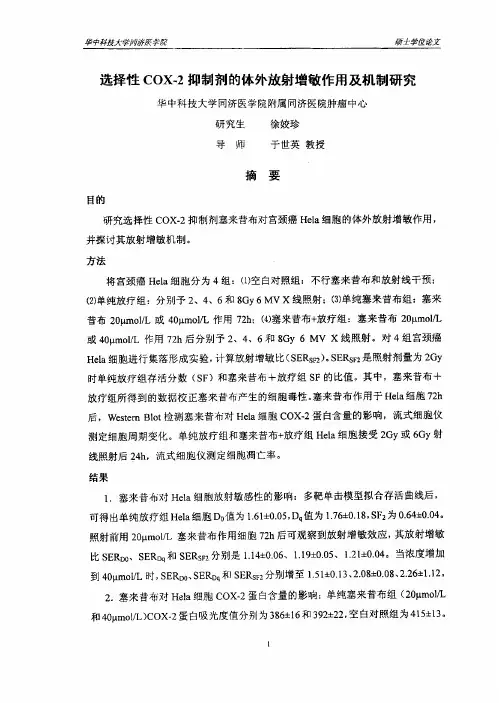
华中科技大学同济躁学皖硕士学位论文选择性COX一2抑制剂的体外放射增敏作用及机制研究华中科技大学同济医学院附属同济医院肿瘤中心研究生徐姣珍导师于世英教授摘要目的研究选择性COX.2抑制剂塞来昔布对宫颈癌Hela细胞的体外放射增敏作用,并探讨其放射增敏机制。
方法将富颈癌Hela细胞分为4组:(1)空白对照组:不行塞来昔布和放射线干预;(2)单纯放疗组:分别予2、4、6和8Gy6MVX线照射;(3)单纯塞来昔布组:塞来昔布209mol/L或40I_tmol/L作用72h;(4)塞来昔布+放疗组:塞来昔布209mol/L或409mol/L作用72h后分别予2、4、6和8Gy6MVX线照射。
对4组宫颈癌Hela细胞进行集落形成实验,计算放射增敏比(SERsF2)。
SEKsF2是照射剂量为2Gy时单纯放疗组存活分数(SF)和塞来昔布+放疗组SF的比值。
其中,塞来昔布+放疗组所得到的数据校正塞来昔布产生的细胞毒性。
塞来昔布作用于Hela细胞72h后,WesternBlot检测塞来昔布对Hela细胞COX.2蛋白含量的影响,流式细胞仪测定细胞周期变化。
单纯放疗组和塞来昔布+放疗组Hela细胞接受2Gy或6Gy射线照射后24h,流式细胞仪测定细胞凋亡率。
结果1.塞来昔布对Hela细胞放射敏感性的影响:多靶单击模型拟合存活曲线后,可得出单纯放疗组Hela细胞Do值为1.61士0.05,Dq值为1.76士0.18,SF2为O.64士0.04。
照射前用209mol/L塞来昔布作用细胞72h后可观察到放射增敏效应,其放射增敏比SERDo、SERDq和SERsF2分别是1.14士O.06、1.19士0.05、1.21士0.04。
当浓度增加到409mol/L时,SERD0、SERDn和SERsF2分别增至1.51士O.13、2.08士0.08、2.26M.12a2.塞来昔布对Hela细胞COX一2蛋白含量的影响:单纯塞来昔布组(20lrtmol/L和409moI/L)COX.2蛋白吸光度值分别为386士16和392士22,空白对照组为415士13。
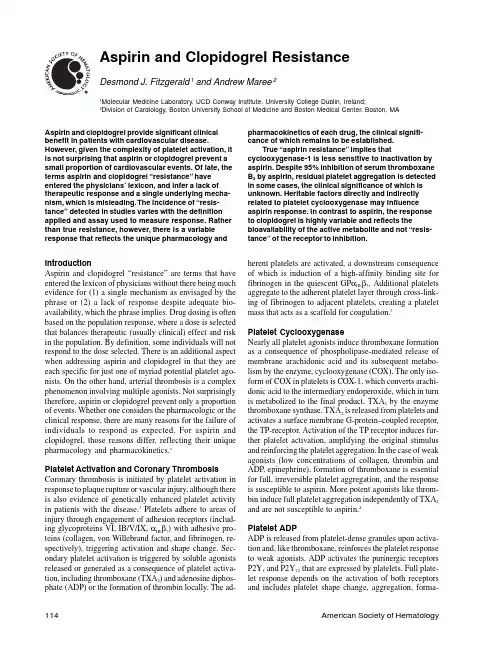
Aspirin and Clopidogrel ResistanceDesmond J. Fitzgerald1 and Andrew Maree21Molecular Medicine Laboratory, UCD Conway Institute, University College Dublin, Ireland;2Division of Cardiology, Boston University School of Medicine and Boston Medical Center, Boston, MAAspirin and clopidogrel provide significant clinical benefit in patients with cardiovascular disease. However, given the complexity of platelet activation, it is not surprising that aspirin or clopidogrel prevent a small proportion of cardiovascular events. Of late, the terms aspirin and clopidogrel “resistance” have entered the physicians’ lexicon, and infer a lack of therapeutic response and a single underlying mecha-nism, which is misleading. The incidence of “resis-tance” detected in studies varies with the definition applied and assay used to measure response. Rather than true resistance, however, there is a variable response that reflects the unique pharmacology and pharmacokinetics of each drug, the clinical signifi-cance of which remains to be established.True “aspirin resistance” implies that cyclooxygenase-1 is less sensitive to inactivation by aspirin. Despite 95% inhibition of serum thromboxane B2 by aspirin, residual platelet aggregation is detected in some cases, the clinical significance of which is unknown. Heritable factors directly and indirectly related to platelet cyclooxygenase may influence aspirin response. In contrast to aspirin, the response to clopidogrel is highly variable and reflects the bioavailability of the active metabolite and not “resis-tance” of the receptor to inhibition.IntroductionAspirin and clopidogrel “resistance” are terms that have entered the lexicon of physicians without there being much evidence for (1) a single mechanism as envisaged by the phrase or (2) a lack of response despite adequate bio-availability, which the phrase implies. Drug dosing is often based on the population response, where a dose is selected that balances therapeutic (usually clinical) effect and risk in the population. By definition, some individuals will not respond to the dose selected. There is an additional aspect when addressing aspirin and clopidogrel in that they are each specific for just one of myriad potential platelet ago-nists. On the other hand, arterial thrombosis is a complex phenomenon involving multiple agonists. Not surprisingly therefore, aspirin or clopidogrel prevent only a proportion of events. Whether one considers the pharmacologic or the clinical response, there are many reasons for the failure of individuals to respond as expected. For aspirin and clopidogrel, those reasons differ, reflecting their unique pharmacology and pharmacokinetics.1Platelet Activation and Coronary Thrombosis Coronary thrombosis is initiated by platelet activation in response to plaque rupture or vascular injury, although there is also evidence of genetically enhanced platelet activity in patients with the disease.2 Platelets adhere to areas of injury through engagement of adhesion receptors (includ-ing glycoproteins VI, IB/V/IX, αIIbβ3) with adhesive pro-teins (collagen, von Willebrand factor, and fibrinogen, re-spectively), triggering activation and shape change. Sec-ondary platelet activation is triggered by soluble agonists released or generated as a consequence of platelet activa-tion, including thromboxane (TXA2) and adenosine diphos-phate (ADP) or the formation of thrombin locally. The ad-herent platelets are activated, a downstream consequence of which is induction of a high-affinity binding site for fibrinogen in the quiescent GPαIIbβ3. Additional platelets aggregate to the adherent platelet layer through cross-link-ing of fibrinogen to adjacent platelets, creating a platelet mass that acts as a scaffold for coagulation.3Platelet CyclooxygenaseNearly all platelet agonists induce thromboxane formation as a consequence of phospholipase-mediated release of membrane arachidonic acid and its subsequent metabo-lism by the enzyme, cyclooxygenase (COX). The only iso-form of COX in platelets is COX-1, which converts arachi-donic acid to the intermediary endoperoxide, which in turn is metabolized to the final product, TXA2 by the enzyme thromboxane synthase. TXA2 is released from platelets and activates a surface membrane G-protein–coupled receptor, the TP-receptor. Activation of the TP receptor induces fur-ther platelet activation, amplifying the original stimulus and reinforcing the platelet aggregation. In the case of weak agonists (low concentrations of collagen, thrombin and ADP, epinephrine), formation of thromboxane is essential for full, irreversible platelet aggregation, and the response is susceptible to aspirin. More potent agonists like throm-bin induce full platelet aggregation independently of TXA2 and are not susceptible to aspirin.4Platelet ADPADP is released from platelet-dense granules upon activa-tion and, like thromboxane, reinforces the platelet response to weak agonists. ADP activates the purinergic receptors P2Y1 and P2Y12 that are expressed by platelets. Full plate-let response depends on the activation of both receptors and includes platelet shape change, aggregation, forma-tion of thromboxane and expression of surface tissue fac-tor. ADP is rapidly metabolized and indeed, at low concentra-tions, the platelet activation is reversible. At high concentra-tions of ADP, platelet aggregation is irreversible. Hereditary absence of the P2Y12 receptor results in a mild bleeding di-athesis and unstable platelet aggregate formation.5The Pharmacology of AspirinAspirin (acetylsalicylate) is hydrolyzed more rapidly in alkaline conditions to the inactive salicylate. As it has a low pKa, it is absorbed in the stomach and appears in the blood within 10 minutes, with peak plasma concentrations seen at 30 to 40 minutes. Aspirin is metabolized by es-terases in blood and in the liver and has a half-life of 15 minutes. The bioavailability of regular, soluble aspirin (that is, the amount detected systemically) is 50%, but this is lower for controlled-release preparations.6 The major me-tabolite, salicylate has a half-life of 3 to 6 hours depending on the dose and, unlike aspirin, can be detected in plasma and urine long after the active drug has been eliminated. Given its instability, it is difficult to measure aspirin in biological samples, particularly when given in low doses. Studies with low dose, controlled-release aspirin have found platelet inhibition prior to any detectable aspirin in the systemic circulation. This arises as aspirin exerts its effect on platelets in the portal or presystemic circulation and is subsequently removed by the liver. Thus, inhibition of platelets is often used as a surrogate measure of aspirin bioavailability.7The target for aspirin is COX, of which there are two isoforms, COX-1 and COX-2. COX-1 is ubiquitously expressed and is the only isoform in platelets, where it generates TXA2. COX-1 is also expressed in vascular endothelium, where it generates prostacyclin (PGI2), the major cyclooxygenase product of these cells. COX-2 is an inducible gene and is found at sites of inflammation and in many cancers. COX-2 is largely absent in healthy subjects, but is nevertheless expressed in sufficient amounts to generate PGI2.8 Aspirin is a nonselective COX inhibitor, inhibiting both isoforms. Yet, at low dose in humans, aspirin is relatively selective for platelet COX-1. The explanation lies in both the irreversible effect of aspirin on the enzyme and the slow turnover of COX-1 in platelets. Aspirin acetylates a serine in the substrate pocket of the enzyme and conse-quently through bulk action alters the positioning of the substrate arachidonic acid, preventing its metabolism to the endoperoxide. In the case of COX-1, the enzyme is in-activated and as the reaction is irreversible, no thrombox-ane is generated for the lifetime of the platelet (about 10 days). (In the case of COX-2, the enzyme is converted to a lipoxygenase.) This is because platelets have a low capac-ity to generate protein (they are anucleate), and so new platelets must be generated to restore cyclooxygenase ac-tivity.9 Thus, following a single 100-mg dose of aspirin, the ability of whole blood to generate TXA2 recovers in parallel with the appearance of new platelets and achieves pre-treatment levels at 8 to 10 days. Maintenance of the effect requires only a small dose of aspirin, as low as 40 mg daily. Thus, despite its rapid inactivation in the body, aspi-rin has a long-term effect on platelets that can be main-tained by just once-a-day administration.10 The model as-sumes a low platelet turnover. Where platelet turnover is increased, higher doses of aspirin may be required. Measuring Aspirin’s EffectIn platelets, COX-1 generates TXA2, which in turn is rap-idly and nonenzymatically converted to the inactive TXB2. TXB2 is metabolized enzymatically to a range of products, the most abundant being 11-dehydro- TXB2 and 2,3-dinor-TXB2, both of which are excreted in urine. Aspirin’s inhibi-tion of COX-1 is best assessed directly by measuring the capacity of platelets to generate TXB2. Nonanticoagulated blood is incubated at 37ºC for at least 45 minutes to induce maximum platelet activation and release of the substrate for metabolism to TXB2. Aspirin reduces this assay of se-rum TXB2 by at least 95% when adequately dosed. Mea-sures of plasma TXB2 are less informative. The levels are so low that it is difficult to discern a reduction, and what is measured is often an artefact of platelet activation during sampling. Aspirin also reduces urinary thromboxane me-tabolites, but as these are not solely derived from platelet TXB2, the assay is less informative about the degree of platelet inhibition.11As an alternative strategy, the effect of aspirin can be estimated by assays of platelet activity, usually platelet aggregation in response to agonists such as arachidonic acid, epinephrine and collagen. The response to more po-tent agonists like thrombin is less dependent on platelet cyclooxygenase and is unaffected. More recently, bedside assays have been developed that provide a more rapid as-say of platelet function and have been used to detect inad-equate response to aspirin (see Table 1). These include the PFA-100, in which a sample of blood is forced through a capillary containing both collagen and a platelet agonist (e.g., epinephrine) and the time to cessation of flow (caused by platelet aggregation) is the measure of platelet activity. Aspirin prolongs the closure time, and thus the PFA-100 has been used to assess the response to aspirin in patients.12 Variation in the Response to AspirinAll drugs show variation in response, which is not surpris-ing given the heterogeneity of the population. (The most common reason is variation in pharmacokinetics reflect-ing the heterogeneity in volume of distribution [weight, fat] and/or drug metabolism.) The response to drugs is nor-mally distributed in most cases, so that by definition some patients fall into the lower extreme end of response.13 For aspirin this is largely irrelevant, as doses as low as 30 mg daily effectively inactivate platelet cyclooxygenase. There are, nevertheless, circumstances where low doses of aspirin may prove inadequate, such as when platelet turnover is increased (for example, following surgery or in myelopro-liferative disease).14 Newer preparations of aspirin, designed to release aspirin beyond the stomach, may have a lower bioavailability and deliver a lower amount of active drug. In such cases, overweight patients may show a less than expected degree of platelet inhibition. This does not ap-pear to be an issue with regular, soluble aspirin, where at 75 mg daily there is almost complete inhibition of platelet cyclooxygenase in nearly every patient.6,15The Rising Tide of “Aspirin Resistance”In recent times, there has been a flood of papers suggesting that there are patients who are “resistant” to aspirin (Table 1).1 Of course, aspirin is a relatively weak antithrombotic agent in that it reduces the risk of serious cardiovascular events by little more than 20% (it is higher, perhaps 40% to 50% in higher-risk diseases, such as acute coronary syn-drome).23 Here, the explanation is largely related to the complexity of the disease, primarily coronary thrombosis. Coronary thrombosis arises from vascular injury, either long-standing or acute plaque disruption, where platelets adhere to the vessel wall, thereby triggering a cascade of events reinforced by the generation of thromboxane. Many platelet activation pathways are implicated, include adhe-sion-mediate outside-in signaling, shear-induced activa-tion of adhered platelets, the local formation of thrombin,and the release of platelet agonists, including TXA2, ADP and growth arrest–specific (GAS) gene 6.24 Aspirin influ-ences just one of these pathways and not surprisingly has a limited effect. Few, if any, of the patients failing to respond clinically to aspirin are “resistant” to the drug.25 That said, there may be circumstances where aspirin in regular doses may not have the desired platelet inhibition. The target for aspirin is >95% inhibition of serum TXB2, as at lower levels of inhibition, sufficient TXA2 is generated to support platelet aggregation to some extent. Several stud-ies have shown that this is achieved at a dose of regular aspirin of 75 mg daily in virtually every case. At more than 95% inhibition of serum TXB2, there is near complete inhi-bition of platelet aggregation to weak agonists. Whether suppression of this residual degree of platelet activity trans-lates into a greater clinical benefit is doubtful, as the clini-cal response to aspirin across large-scale studies is not dose related at doses greater than 75 mg daily.“True Aspirin Resistance”True aspirin resistance implies that the target, cyclooxygenase, is less sensitive to inactivation by aspi-rin. In one study, Maree and colleagues examined serum TXB2 and platelet aggregation to arachidonic acid in pa-tients with coronary artery disease on aspirin and relatedTable 1. Prospective studies of variable platelet response to aspirin and clinical events.AspirinPatients dose (meanStudy(no.; % female;follow-up Aspirin resistance assay Clinical outcome(year)mean age, y)period)(prevalence)associated with aspirin resistance Grotemeyer et al16Prior CVA500 mg TID Platelet reactivity test (33%)OR 14.53 (5.16-40.9); P < .0001 (1993)(180; 41; 58)(2 y)Risk of stroke, MI or vascular death Mueller et al17Intermittent claudication100 mg/d Corrected whole blood aggregometry*87% higher risk of lesion reocclusion (1997)(100; 30; 62.5)(1.5 y)post peripheral vascular angioplasty(P = .009)Eikelboom et al18High cardiovascular risk Unspecified Urinary 11-dehydro TXB2Upper versus lower quartile OR 1.8 (2002)(976; 15.8; 67)(5 y)(quartile comparison)(1.2-2.7)Risk of MI, CVA or cardiovascular death Gum et al19Stable coronary artery325 mg/d Optical aggregometry (5.2%)†OR 3.12 (1.1-8.9)(2003)disease (326; 22.4; 62)(1.86 y)Risk of MI, CVA, all cause deathChen et al20Non-urgent PCI80-325 mg Ultegra rapid platelet function assay-OR 3.29 (1.42-7.59); P < .01(2004)(151; 24.5; 64)(24 h) ASA 19.2%‡Risk of myonecrosis post PCI(CK-MB = 16 U/L)Poston et al21Patients undergoing off-325 mg/d Thromboelastography§Early SVG thrombosis - 45%(2006)pump coronary artery(30 d)Whole blood sggregometry (collagen)ASA resistant versus patent SVG 20% bypass grafting11-dehydro-TXB2 (30%)ASA resistant; P < .05(225; 34; 69)Ohmori et al22Prior cerebral infarct or81 mg Optical aggregometry (collagen)HR 7.98; P = .008(2006)ischemic heart disease(1 y)PA-20 platelet aggregation analyzer Risk of cardiovascular events if upper (140; 53.7; 75.4)(quartile comparison)quartile (optical aggregometry)HR 7.76; P = .007Risk of cardiovascular events (PA-20analysis)Adapted from Maree and Fitzgerald, with permission.1Abbreviations: TID, three times a day; OR, overall response; MI, myocardial infarction;CVA, cerebrovascular accident; ASA, aspirin; PCI, percutaneous coronary intervention; CK-MB, creatine kinase isoenzyme MB; HR, hazard ratioResistance defined as persistent aggregation to ADP and collagen.†Resistence defined as mean aggregation ≥70% with 10 µM ADP and mean aggregation of ≥20% with 0.5 mg/mL arachidonic acid.‡Propyl gallate agonist, resistance defined as ≥550 aspirin response units.§Resistence defined as 2 of 3 assays positive.this to polymorphisms in the COX-1 gene. The response to aspirin was related to the haplotype (the pattern of variants in an individual), without a clear explanation, as only one variant was predicted to affect the structure of the protein. Whether other variants (possibly linked to the known vari-ants) exist has yet to be addressed, requiring resequencing of the gene in a larger population.26 Others associated aspi-rin resistance, determined by the PFA-100 point-of-care platelet function assay (collagen and epinephrine cartridge) with increased expression of three vitamin D–binding pro-tein isotypes.27 In effect, genetic variation in any platelet-signaling component, whether directly targeted by a drug or not, has the potential to influence drug response. This is borne out by a recent study of healthy volunteers showing that both baseline platelet function and persistent platelet activation in the presence of aspirin largely reflected sig-naling via COX-1–independent pathways and that this was an inherited trait.25 Not surprisingly, platelet activity and bleeding time response to antiplatelet therapy are to some extent inherited.2,28Aspirin and Nonsteroidal Antiinflammatory Drugs There is one circumstance in which the pharmacologic re-sponse to aspirin may be impaired, namely when a nonste-roidal anti-inflammatory drug (NSAID) has been adminis-tered prior to aspirin. This has been reported primarily with ibuprofen, a nonselective cyclooxygenase inhibitor. Ibupro-fen inhibits COX-1 in part through binding to the arginine-120 at the mouth to the substrate-binding site. The drug has a long plasma half-life (4-6 hours) and therefore inhib-its the enzyme for several hours. In so doing, ibuprofen prevents aspirin from accessing the target serine in the ac-tive site. As aspirin is rapidly inactivated to form salicy-late, and therefore is active for a relatively short period, it fails to inactivate the enzyme. Ibuprofen is a reversible inhibitor of COX-1 and washes out, leaving the enzyme uninhibited. In effect, prior dosing with ibuprofen blocks the inhibition by aspirin.29 There is evidence of a higher than expected event rate in patients on aspirin who take NSAIDs regularly, which is consistent with the hypothesis that NSAIDs interfere with the action of aspirin. However, other mechanisms may be responsible, as there is growing evidence that some NSAIDs are associated with a higher rate of cardiovascular events even in patients not on aspirin.30 Clinical Studies of “Aspirin Resistance”Many studies have examined the response to aspirin in patients with cardiovascular disease and have reported “as-pirin resistance” in as many as 33% of subjects (Table 1). Given what has been outlined above, this is a surprisingly high frequency. The explanation lies in the definition, which is often based on an arbitrary level of platelet activ-ity and on assays that are not solely measuring platelet cyclooxygenase activity. For example, while the closure time of the PFA-100 (often used in studies) and platelet aggregation to agonists are to some extent dependent on platelet thromboxane formation, other platelet activation pathways that are insensitive to aspirin are undoubtedly involved.Studies based on serum TXB2 are few and in general report a very low rate of “aspirin resistance.” Several stud-ies have examined urinary excretion of 11-dehydro-TXB2 and report incomplete suppression of this index of whole-body thromboxane formation. Moreover, the continued ex-cretion of 11-dehydro-TXB2 was related to subsequent car-diovascular events. The assay does not solely measure thromboxane generated by platelets, but also detects throm-boxane generated by other tissues. Indeed, there is good evidence that atherosclerotic plaque can generate throm-boxane and this may explain its continued generation and contribution to disease progression.18Clinical Outcome and Aspirin ResistanceThere have been few studies examining the outcome of patients demonstrating “aspirin resistance,” and all have their flaws. In many cases, the assay used measured residual platelet activity and not the primary response to aspirin. Small studies have explored the clinical utility of point-of-care platelet function assays.20,31 All are case-control stud-ies or prospective comparisons between groups and are not randomized. The likelihood of a randomized study capable of discriminating the benefit of complete suppression of platelet cyclooxygenase being adequately powered is low, given how many studies were required to show a beneficial effect of aspirin in the first place.Pharmacology of ClopidogrelClopidogrel is one of a series of compounds developed as antagonists of P2Y12. These compounds inhibit platelet aggregation to a range of agonists in addition to ADP, as the response to many agonists is in part dependent on the release of ADP from platelet dense granules. Strong ago-nists, such as thrombin, are, however, unaffected by clopido-grel. Clopidogrel is a prodrug and needs to be activated in vivo to form an active metabolite that binds irreversibly and selectively to the P2Y12 receptor. Active P2Y12 recep-tors exist in homo-oligomeric complexes within special-ized, lipid-rich regions of the platelet cell membrane known as lipid rafts, which act as scaffolds for signal transduction complexes. The active metabolite of clopidogrel disrupts these oligomers and thereby prevents signal transduction.32 Like aspirin, daily doses of clopidogrel have a cumulative and prolonged effect that is dissociated from the plasma half-life of the parent drug. At regular, daily doses of clopidogrel, platelet inhibition increases over days, and following its dis-continuation, platelet responses to ADP recover slowly in parallel with the formation of new platelets.33Measuring Clopidogrel’s EffectPlatelet aggregation to ADP is often used as an assay of the response to clopidogrel. The platelet response to ADP and inhibition by clopidogrel is highly dependent on the con-centration of the agonist. At low concentrations, the re-sponse to ADP is highly dependent on the generation of thromboxane and is inhibited by aspirin.1 Higher concen-trations of ADP induce full and irreversible platelet aggre-gation that is insensitive to aspirin but is inhibited by up to 90% in the presence of a P2Y12 antagonist. Thus, the assay is an effective means of assessing the response to clopido-grel. Other point-of-care assays are sensitive to P2Y12 an-tagonism. The PFA100, for example, can be designed to examine the response to ADP, and the time to closure is prolonged in patients on clopidogrel.12Variation in the Response to Clopidogrel Inhibition of platelet aggregation to ADP by clopidogrel is highly variable and shows a normal distribution, with an average of 40% to 50% inhibition.34 This wide variation in response reflects several issues, including poor compliance with medication, variable absorbance of the parent drug and variability in formation of the active metabolite.Clopidogrel is activated by CYP3A4, one of a series of cytochrome P450 enzymes involved in drug metabolism. The activity of the enzyme varies widely in the popula-tion, as has been reported for other cytochrome P450 en-zymes, with the result that the activity of clopidogrel is similarly heterogeneous. In part, this may reflect genetic variation in the enzyme although coadministration of drugs that are metabolized by the enzyme and environmental fac-tors may influence the activation of clopidogrel. Not sur-prisingly, therefore, there is a wide variation in the platelet response to clopidogrel when a standard daily dose is ad-ministered. Thus, platelet aggregation to high concentra-tions of ADP can show minimal inhibition or marked sup-pression in patients on clopidogrel.34 The response is dose dependent and is augmented by the addition of a P2Y12 antagonist or the active clopidogrel metabolite in vitro.35 This suggests that the variability in response reflects the variable bioavailability of the active metabolite and not “resistance” of the receptor to inhibition by the drug.Table 2. Studies of variable platelet response to clopidogrel with clinical correlation.Patients Clopidrogel Clopidrogel Clinical outcome associated withStudy(no.;% female;dose (mean resistance assay clopidrogel resistance(year)mean age, y)follow-up period)(prevalence)(assay results in stent thrombosis studies) Mobley et al39Patients undergoing PCI75 mg daily Optical aggregometry No correlation with major adverse(2004)(50; 20; 58)maintenance 1 µmol/L ADP;clinical events300 mg loading<10% average platelet inhibitionclinician’s discretion(30%)6/12Matetzky et al40Patients undergoing300 mg load post PCI,Optical aggregometry Recurrent cardiovascular events(2004)primary PCI for acute then 75 mg daily 5 µmol/L ADP(40% vs 6.7%; P = .007)STEMI x 3/12 (6 mo)(1st quartile comparison(60; 20; 58)to remainder)Gurbel et al41Patients undergoing PCI300 mg or 600 mg Optical aggregometry Ischemic events (upper quartile)(2005)(192; 44; 61)loading, 75 mg daily 5 and 20 µmol/L ADP ADP aggregation(6 mo)TEG hemostasis analyzer(63 ± 12% vs 56 ± 15%, P = .02)(upper quartile comparison Clot strengthto remainder)(74 ± 5 mm vs 65 ± 4 mm, P < .001)Time to fibrin generation(4.3 ± 1.3 min vs 5.9 ± 1.5 min, P < .001) Barragan et al42Stent thrombosis (<30 d)Clopidogrel 75 mg Flow cytometric assay Platelet reactivity in patients with stent (2003)vs no stent thrombosis twice daily or VASP phosphorylation thrombosis vs no stent thrombosis(48 [16 cases]; 26;ticlopidine 250 mg(% platelet reactivity)(63.28% ± 9.56% vs 39.8 ± 10.9%;67)twice daily P < .0001)Ajzenberg et al43Stent thrombosis vs300 mg load after PCI,Coaxial cylinder shearing device Shear 200 S-1(2005)no stent thrombosis then 75 mg daily Shear-induced platelet aggregation(40.9 ± 12.2% vs18.2 ± 18%, P = .013)(32 [10 cases]; 85;×3/12Shear 4000 S-158)(57.4 ± 16.4% vs 23.4 ± 21.2%, P = .009) Gurbel et al44Stent thrombosis vs75 mg daily ±Optical aggregometry 5 µmol/L ADP aggregation(2005)no stent thrombosis300 mg loading 5 and 20 µmol/L ADP(49 ± 4% vs 33 ± 2%; P < .05) (120 [20 cases]; 43;P2Y12 reactivity ratio by20 µmol/L ADP aggregation63)VASP phosphorylation(65 ± 3% vs 51 ± 2%; P < .001)Flow cytometry assay of P2Y12 reactivity ratioGPIIb/IIIa expression(69 ± 5% vs 46 ± 9%; P = .03)(upper quartile comparison Mean fluorescence intensity for stimulatedto remainder)GPIIb/IIIa expression(138 ± 19 vs 42 ± 4; P < .001)Buonamici et al45Stent thrombosis vs600 mg loading,Optical aggregometry 10 µmol/L ADP;Definite/probable stent thrombosis (2007)no stent thrombosis75mg daily aggregation ≥70% (13%)In responders vs non-responders (804 [25 cases]; 25;(6 mo)16/699 (2.3%) vs 9/105 (8.6%); P < .001N/A)Adapted from Maree and Fitzgerald, with permission.1Abbreviations: PCI, percutaneous coronary intervention; ADP, adenosine diphosphate; STEMI, ST segment elevation myocardial infarction; VASP, vasodilator-stimulated phosphoprotein。
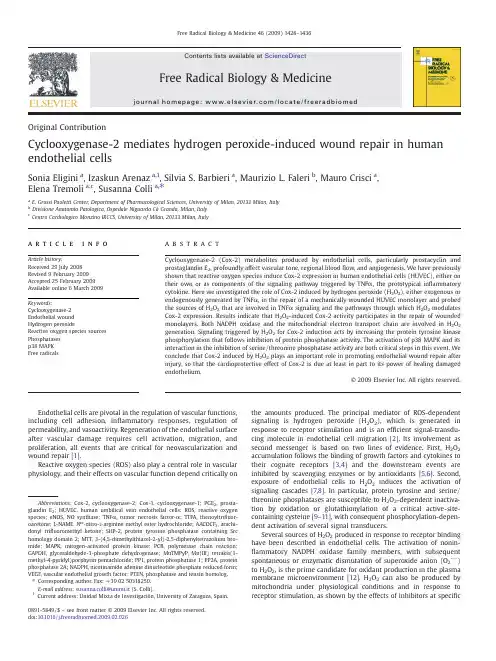
Original ContributionCyclooxygenase-2mediates hydrogen peroxide-induced wound repair in human endothelial cellsSonia Eligini a ,Izaskun Arenaz a ,1,Silvia S.Barbieri a ,Maurizio L.Faleri b ,Mauro Crisci a ,Elena Tremoli a ,c ,Susanna Colli a ,⁎a E.Grossi Paoletti Center,Department of Pharmacological Sciences,University of Milan,20133Milan,Italyb Divisione Anatomia Patologica,Ospedale Niguarda CàGranda,Milan,Italy cCentro Cardiologico Monzino IRCCS,University of Milan,20133Milan,Italya b s t r a c ta r t i c l e i n f o Article history:Received 29July 2008Revised 9February 2009Accepted 25February 2009Available online 6March 2009Keywords:Cyclooxygenase-2Endothelial wound Hydrogen peroxideReactive oxygen species sources Phosphatases p38MAPK Free radicalsCyclooxygenase-2(Cox-2)metabolites produced by endothelial cells,particularly prostacyclin and prostaglandin E 2,profoundly affect vascular tone,regional blood flow,and angiogenesis.We have previously shown that reactive oxygen species induce Cox-2expression in human endothelial cells (HUVEC),either on their own or as components of the signaling pathway triggered by TNF α,the prototypical in flammatory cytokine.Here we investigated the role of Cox-2induced by hydrogen peroxide (H 2O 2),either exogenous or endogenously generated by TNF α,in the repair of a mechanically wounded HUVEC monolayer and probed the sources of H 2O 2that are involved in TNF αsignaling and the pathways through which H 2O 2modulates Cox-2expression.Results indicate that H 2O 2-induced Cox-2activity participates in the repair of wounded monolayers.Both NADPH oxidase and the mitochondrial electron transport chain are involved in H 2O 2generation.Signaling triggered by H 2O 2for Cox-2induction acts by increasing the protein tyrosine kinase phosphorylation that follows inhibition of protein phosphatase activity.The activation of p38MAPK and its interaction in the inhibition of serine/threonine phosphatase activity are both critical steps in this event.We conclude that Cox-2induced by H 2O 2plays an important role in promoting endothelial wound repair after injury,so that the cardioprotective effect of Cox-2is due at least in part to its power of healing damaged endothelium.©2009Elsevier Inc.All rights reserved.Endothelial cells are pivotal in the regulation of vascular functions,including cell adhesion,in flammatory responses,regulation of permeability,and vasoactivity.Regeneration of the endothelial surface after vascular damage requires cell activation,migration,and proliferation,all events that are critical for neovascularization and wound repair [1].Reactive oxygen species (ROS)also play a central role in vascular physiology,and their effects on vascular function depend critically onthe amounts produced.The principal mediator of ROS-dependent signaling is hydrogen peroxide (H 2O 2),which is generated in response to receptor stimulation and is an ef ficient signal-transdu-cing molecule in endothelial cell migration [2].Its involvement as second messenger is based on two lines of evidence.First,H 2O 2accumulation follows the binding of growth factors and cytokines to their cognate receptors [3,4]and the downstream events are inhibited by scavenging enzymes or by antioxidants [5,6].Second,exposure of endothelial cells to H 2O 2induces the activation of signaling cascades [7,8].In particular,protein tyrosine and serine/threonine phosphatases are susceptible to H 2O 2-dependent inactiva-tion by oxidation or glutathionylation of a critical active-site-containing cysteine [9–11],with consequent phosphorylation-depen-dent activation of several signal transducers.Several sources of H 2O 2produced in response to receptor binding have been described in endothelial cells.The activation of nonin-flammatory NADPH oxidase family members,with subsequentspontaneous or enzymatic dismutation of superoxide anion (O 2U−)to H 2O 2,is the prime candidate for oxidant production in the plasma membrane microenvironment [12].H 2O 2can also be produced by mitochondria under physiological conditions and in response to receptor stimulation,as shown by the effects of inhibitors at speci ficFree Radical Biology &Medicine 46(2009)1428–1436Abbreviations:Cox-2,cyclooxygenase-2;Cox-1,cyclooxygenase-1;PGE 2,prosta-glandin E 2;HUVEC,human umbilical vein endothelial cells;ROS,reactive oxygen species;eNOS,NO synthase;TNF α,tumor necrosis factor-α;TTFA,thenoyltri fluor-oacetone;L-NAME,N ω-nitro-L -arginine methyl ester hydrochloride;AACOCF 3,arachi-donyl tri fluoromethyl ketone;SHP-2,protein tyrosine phosphatase containing Src homology domain 2;MTT,3-(4,5-dimethylthiazol-2-yl)-2,5-diphenyltetrazolium bro-mide;MAPK,mitogen-activated protein kinase;PCR,polymerase chain reaction;GAPDH,glyceraldehyde-3-phosphate dehydrogenase;MnTMPyP,Mn(III)tetrakis(1-methyl-4-pyridyl)porphyrin pentachloride;PP1,protein phosphatase 1;PP2A,protein phosphatase 2A;NADPH,nicotinamide adenine dinucleotide phosphate reduced form;VEGF,vascular endothelial growth factor;PTEN,phosphatase and tensin homolog.⁎Corresponding author.Fax:+390250318250.E-mail address:susanna.colli@unimi.it (S.Colli).1Current address:Unidad Mixta de Investigaciòn,University of Zaragoza,Spain.0891-5849/$–see front matter ©2009Elsevier Inc.All rights reserved.doi:10.1016/j.freeradbiomed.2009.02.026Contents lists available at ScienceDirectFree Radical Biology &Medicinej o u r n a l h o me p a g e :w w w.e l sev i e r.c o m /l oc a t e /fr e e ra d b i o me dmitochondrial sites in the electron transport chain upon oxygen sensing-related vascular signaling[13,14].In addition,other signifi-cant sources of endothelial ROS are cyclooxygenases(Cox's)and NO synthase(eNOS)[15,16,9].Arachidonic acid metabolites are important in the modulation of vascular homeostasis[17].The major rate-limiting enzymes involved in their synthesis are Cox's.Cox-1is constitutively expressed in most tissues and has general housekeeping functions,whereas Cox-2is responsible for high-level production of prostanoids in response to proinflammatory agents,tumor promoters,and growth factors[18]. Enzymatic Cox-2activity may serve as a compensatory mechanism to preserve the vasodilatory and antithrombotic properties of the vessel wall[19].Indeed,Cox-2metabolites produced by endothelial cells, particularly prostacyclin and prostaglandin E2(PGE2),have profound influences on vascular tone,regional bloodflow,vascular permeability and remodeling,angiogenesis,and wound repair[20,21].The balance between these autacoids is consequently critical in many pathophy-siological processes.We previously showed that ROS induce Cox-2expression in human endothelial cells,either on their own or as components of the inflammatory TNFαsignaling pathway[22].We therefore investi-gated whether Cox-2induced by H2O2affects the repair of a wounded endothelial monolayer and explored the signaling pathways whereby H2O2promotes Cox-2expression in endothelial cells.Materials and methodsMaterialsHuman recombinant tumor necrosis factor-α(TNFα)was from R and D Systems(Space Import–Export,Milan,Italy).PGE2,rote-none,thenoyltrifluoroacetone(TTFA),okadaic acid,calyculin A, H2O2,Nω-nitro-L-arginine methyl ester hydrochloride(L-NAME), sodium orthovanadate,sodium pyruvate,apocynin(4-hydroxy-3-methoxyacetophenon),and crystal violet were from Sigma–Aldrich S.r.l.(Milan,Italy).Stigmatellin and p-nitrophenyl phosphate were from Fluka(Sigma–Aldrich S.r.l.).SB203580,MnTMPyP,and NS-398were from Biomol(Tebu-Bio,Milan,Italy).Arachidonic acid sodium salt and the stable prostacyclin analog iloprost were from Cayman Chemical(Spi-Bio,Montigny Le Bretonneux,France). Arachidonyl trifluoromethyl ketone(AACOCF3)was from Alexis (Vinci-Biochem,Vinci,Firenze,Italy).NSC-87877,a selective inhibitor of the protein tyrosine phosphatase containing the Src homology domain2(SHP-2)was from Acros Organics(Nova Chimica,Milan,Italy).Antibodies against Cox-2(Ab29)and Cox-1 were gifts from Aida Habib(American University of Beirut, Lebanon)and from Cayman Chemical,respectively.Antibody against SHP-2and protein A/G–agarose were from Santa Cruz Biotechnology(Tebu-Bio,Milan,Italy).Antibody against phospho-tyrosine was from Upstate Biotechnology(Millipore,Milan,Italy). Antibodies against phosphorylated and total p38MAPK were from Biosource(Prodotti Gianni S.p.A,Milan,Italy).Peroxidase-con-jugated anti-mouse IgG antibody was from Jackson Immuno-Research Labs(Li StarFISH,Milan,Italy).Antibody directed against β-actin was from Sigma–Aldrich.Cell culture and treatmentHuman umbilical vein endothelial cells(HUVEC)were isolated from freshly acquired human umbilical veins,as described[22]. Informed consent was provided according to the Declaration of Helsinki.Cells were cultured in medium199(BioWhittaker Italia S.r.l., Bergamo,Italy)supplemented with10%heat-inactivated pooled human AB serum,1mM L-glutamine,50U/ml penicillin,50μg/ml streptomycin,0.1mg/ml neomycin,15μg/ml heparin,and50μg/ml crude extract of endothelial cell growth factor.Cells were used at the first passage.Heparin and endothelial cell growth supplement were omitted24h before stimulation.Incubations were carried out in M199medium supplemented with0.75%bovine serum albumin (fatty-acid-free and low in endotoxin;Sigma–Aldrich)and1%fetal calf serum.Inhibitors were added1h before stimulation.Cytotoxicity measurementCell viability was assayed with the use of either neutral red or MTT reduction assay and calculated as follows:relative viability= [(A e–A b)/(A c–A b)]×100,where A b is the background absorbance, A e is the experimental absorbance,and A c is the absorbance of controls.The various agents,at the concentrations tested,did not affect cell viability after either6or16h incubation.A slight reduction in viability,detected by MTT,was observed when HUVEC were incubated with stigmatellin and subsequently exposed to TNFα.Data (medians and ranges)were92.7%viable cells(76.5–100%),p=0.12, n=5,and84.5%viable cells(70–100%),p=0.25,n=4,vs cells incubated with TNFαfor6and16h,respectively.Prostanoid production assayCox-2activity was determined in HUVEC exposed to stimuli for6h. Cells were washed in Hanks'buffer,pH7.4,containing1mg/ml bovine serum albumin and incubated for30min with10μM arachidonic acid in the same buffer.Supernatants were collected and6-keto-PGF1αand PGE2levels were measured by enzyme immunoassay(Cayman Chemical).Western blotCells were harvested in lysis buffer,pH6.8,as described[22].Cell debris was removed by centrifugation(10,000g for5min)and protein concentration was determined by the micro-bicinchoninic acid assay. Equal amounts of lysates were subjected to SDS–polyacrylamide gel electrophoresis on7%gels and were transferred onto nitrocellulose membrane by a semidry transfer unit(Hoefer Scientific Instruments). The blots were then incubated with primary antibodies directed against Cox-1(1:500),Cox-2(1:10,000),and phosphorylated and total p38MAPK(1/1000).In some experiments,membranes were stripped and phosphotyrosine was detected with an antibody against phosphotyrosine(1:5000).Horseradish peroxidase-conjugated sec-ondary antibody was used at1:5000dilution.β-Actin was used as internal standard for control of protein load.Bands were detected using enhanced chemiluminescence(Amersham Pharmacia Biotech.).SHP-2immunoprecipitation,Western blotting,and activityCells were scraped in lysis buffer(50mM Tris–HCl,pH7.4,1% Nonidet P-40,0.25%sodium deoxycholate,150mM NaCl,1mM EDTA)supplemented with1mM PMSF,1μg/ml aprotinin,1μg/ml leupeptin,1μg/ml pepstatin,1mM Na3VO4,1mM NaF.Protein concentration was determined.Cell lysates(500μg)were incubated with the antibody to SHP-2(1.5μg)for2h at4°C and with protein A/G Plus–agarose beads for18h at4°C.Beads were washed(three times)in phosphatase buffer(62mM Hepes,pH7,6.25mM EDTA). Immune complexes were resuspended in electrophoresis sample buffer,boiled for3min,and immunoblotted with the anti-SHP-2 antiserum(1:500),as described above.SHP-2phosphatase activity was detected as reported[23].Briefly,immunocomplexes were washed twice in phosphatase buffer and resuspended in100μl of the same buffer containing the substrate p-nitrophenyl phosphate (10mM).Incubation was carried out for30min at37°C and stopped with NaOH(200mM).Substrate dephosphorylation was quantified spectrophotometrically at410nm.1429S.Eligini et al./Free Radical Biology&Medicine46(2009)1428–1436RNA isolation and reverse-transcription PCR(RT-PCR)Total RNA(1μg)was extracted from cells with TRIzol reagent, treated with DNase I(Invitrogen,Milan,Italy),and reverse transcribed(37°C for50min)by M-MLV reverse transcriptase (Invitrogen).The cDNA(1μl)was then subjected to22or30cycles of PCR for GAPDH and Cox-2,respectively(denaturation at94°C for 30s,annealing at55°C for30s,primer extension at72°C for60s), in a reaction mixture(50μl)containing 2.5U platinum Taq polymerase(Invitrogen)and200nM sense and antisense primers for Cox-2or GAPDH.The primers for Cox-2were as previously described[24].All reactions were performed in a Bio-Rad thermal cycler.PCR products were analyzed on2%agarose gel containing ethidium bromide(0.5μg/ml).GAPDH mRNA was used as a control for mRNA loading.Monolayer wound-healing migration assayThe wound-repair model employed confluent HUVEC monolayers maintained in M199supplemented with10%pooled human AB serum in35-mm dishes.The monolayer was wounded by dragging a1000-μl pipette tip along it[25,26],and HUVEC were cultured without (control)or with H2O2or TNFα.Just after wounding or after overnight incubation(16h),monolayers werefixed,stained with crystal violet, and photographed(50×magnification).Inhibitors were added1h before the stimuli.For the evaluation of wound closure undervariousFig.1.H2O2,either exogenously added or intracellularly generated by TNFα,induces closure of HUVEC monolayer wounds via a Cox-2-mediated mechanism.(A)Photomicrographs were taken just after wounding(prestimulation)or after16h incubation in medium alone(control)or in the presence of TNFα10ng/ml,H2O23μM,PGE210nM,or iloprost100nM. The inhibitor of Cox-2activity NS-398(5μM)was incubated with the cells for1h before the addition of TNFαor H2O2that lasted16h.Photomicrographs(50×original magnification)are representative of four individual experiments performed with HUVEC isolated from different cords.Boundaries of the wounds are indicated by lines.Insets represent enlarged regions of HUVEC monolayers.(B)For the evaluation of wound closure under various experimental conditions,the cells that migrated across the wound edge were counted in the regions of the premarked lines.Bar graph represents averaged data,expressed as cell number per threefields.Values are the means±SD for four independent experiments performed with HUVEC isolated from different cords.⁎p b0.05vs control.1430S.Eligini et al./Free Radical Biology&Medicine46(2009)1428–1436experimental conditions,the cells that migrated across the wound edge were counted in the regions of premarked lines(AxioVision4.7 software;Zeiss).Data are expressed as the average of cell number per threefields and the experiments were repeated at least three times using different umbilical cords.Statistical analysisResults are expressed as the mean±SD of the number of determinations indicated,performed with different umbilical cords. Means of two groups were compared using paired Student's t test. Grouped differences were compared with ANOVA(Dunn's and Dunnett's tests).Results from cytotoxicity experiments are expressed as medians and ranges.Medians were compared by Wilcoxon signed-rank test.A value of p b0.05was considered statistically different.ResultsH2O2and TNFαpromote the closure of a wound in a HUVEC monolayer via a Cox-2-mediated mechanismUsing a HUVEC wound repair assay that has been reported to be dependent on intracellular ROS production[25]as well as Cox-2 activity[26],we found that both TNFαand H2O2accelerate the closure of a wounded monolayer after mechanical disruption(Fig.1).NS-398, an inhibitor of Cox-2activity,opposed the entry of cells into denuded areas and wound closure,whereas addition of PGE2to the culture accelerated closure(Fig.1).A similar effect,albeit less pronounced, was observed after exposing monolayers to the prostacyclin analog iloprost(Fig.1).The data indicate that Cox-2activity is critical for H2O2-induced HUVEC monolayer repair.Woundedmonolayers Fig.2.H2O2,either exogenously added or intracellularly generated by TNFα,increases PGE2and6-keto-PGF1αlevels and induces Cox-2expression in HUVEC.(A)HUVEC wereleft unstimulated or were exposed to H2O2for6h.Medium was then replaced with Hanks'buffer containing10μM arachidonic acid and incubation was continued for30min. 6-Keto-PGF1αand PGE2levels were measured in the medium by enzyme immunoassays.The values shown are the means±SD of10independent experiments performed with HUVEC from different cords.⁎p b0.005vs untreated cells.Serum-starved HUVEC were incubated with H2O2or TNFα(B,C)for different times or(D)with increasing concentrations of H2O2for6h.Cox-1and Cox-2proteins were detected by Western analysis.β-Actin was used as a control for protein load.Blots are representative of four to six independent experiments performed with different HUVEC preparations.Densitometry is shown in the bar graphs.Signals were quantified relative toβ-actin.⁎p b0.05vs untreated cells.(E) Cox-2mRNA levels were measured by RT-PCR in HUVEC incubated with3μM H2O2or10ng/ml TNFαfor1h.GAPDH mRNA is shown as a control for RNA loading.Results are representative of six independent experiments.Densitometry is shown in the bar graph.Signals were quantified relative to GAPDH.⁎p b0.05vs untreated cells.1431S.Eligini et al./Free Radical Biology&Medicine46(2009)1428–1436exposed to H 2O 2or TNF αshowed morphologies similar to each other but different from the morphology of untreated cells (Fig.1A,insets).H 2O 2induces Cox-2in HUVECAs previously observed for TNF α[22],exogenous H 2O 2increased the levels of the Cox-2metabolites 6-keto-PGF 1αand PGE 2in the medium of HUVEC incubated with arachidonic acid (Fig.2A).Theincrease was attributable to augmented Cox-2protein levels induced by H 2O 2,either added as a bolus or endogenously generated by TNF α(Figs.2B and C ).Cox-2protein accumulation by H 2O 2was evident at 3h,persisted until 16h (Fig.2B),and was detectable at concentrations (b 10μM)that do not cause oxidative stress in cultured mammalian cells [9](Fig.2D).In contrast,Cox-1protein levels were unaffected (Figs.2B –D ).Cox-2mRNA levels,almost undetectable in unstimulated HUVEC,rose upon cell exposure to H 2O 2or TNF α(Fig.2E).Antioxidants prevent Cox-2induction by H 2O 2The redox status within the cell is critical for Cox-2induction by H 2O 2whether exogenous or endogenous.Alteration of the intracellular oxidant status by sodium pyruvate,which prevents H 2O 2-induced glutathione depletion in HUVEC [8],or by the membrane-permeative superoxide dismutase and catalase mimetic MnTMPyP [27]attenuated Cox-2induction by H 2O 2or TNF α(Fig.3).Different sources of H 2O 2mediate Cox-2induction by TNF αand regulate wound closure in HUVEC monolayersThe contribution of distinct sources of H 2O 2that coexist in endothelial cells was examined in HUVEC exposed to TNF α.First,the role of NADPH oxidase-derived H 2O 2was investigated by use of the NADPH oxidase inhibitor apocynin,which markedly prevented Cox-2induction (Fig.4A).Then the contribution of mitochondrial H 2O 2production was investigated in HUVEC incubated with inhibitors of the various complexes within the electron transport chain.Stigmatellin,which prevents electron transfer by complex III from ubiquinol to both iron –sulfur protein and heme b 566(Qo site)[28],reduced Cox-2levels (Fig.4B),which,conversely,were unaffectedbyFig.3.The intracellular redox status affects Cox-2expression in HUVEC.HUVEC were exposed to sodium pyruvate or to the superoxide dismutase mimetic MnTMPyP for 30min.TNF αor H 2O 2was then added and incubation was continued for 6h.Cox-2was detected by Western analysis.β-Actin was used as a control for protein load.Blots are representative of five or six independent experiments performed with different HUVEC cultures.Densitometry is shown in the bar graphs.Signals were quanti fied relative to β-actin.⁎p b 0.05vs TNF α-or H 2O 2-stimulatedcells.Fig.4.Different sources of ROS mediate Cox-2induction by TNF αand regulate wound closure in HUVEC monolayers.HUVEC were incubated for 1h (A)with apocynin or (B)with the inhibitors of mitochondrial electron transport complexes I,II,and III (rotenone,TTFA,and stigmatellin,respectively).TNF αwas then added and incubation was continued for 6h.Cox-2was detected by Western analysis.β-Actin was used as a control for protein load.Blots are representative of four or five independent experiments performed with different cell cultures.Densitometry is shown in the bar graphs.Signals were quanti fied relative to β-actin.⁎p b 0.05vs TNF α-treated HUVEC;#p b 0.05vs untreated cells.(C)Photomicrographs (50×original magni fication)of wounded HUVEC monolayers incubated with medium alone or with apocynin or stigmatellin for 1h and then exposed to TNF αfor 16h.Photomicrographs are representative of three or four individual experiments performed with HUVEC isolated from different cords.(D)Wound closure under the different experimental conditions was quanti fied by counting the cells that migrated across the wound edge in the regions of the premarked lines.Bar graph represents averaged data,expressed as cell number per three fields.Values are the means ±SD for three independent experiments performed with HUVEC isolated from different cords.⁎p b 0.05vs TNF α-treated HUVEC.1432S.Eligini et al./Free Radical Biology &Medicine 46(2009)1428–1436TTFA,an inhibitor of the electron transport from complex II to ubiquinone [14](Fig.4B).In contrast,rotenone,a complex I inhibitor [29],increased Cox-2levels in HUVEC whether the cells were resting or stimulated (Fig.4B).Finally,the respective contributions of H 2O 2generation by Cox's,lipoxygenases,and uncoupled eNOS were investigated in cells exposed to AACOCF 3(10–20μM)or L-NAME (1mM),which inhibit phospholipase A 2and eNOS activity,respectively.The results obtained exclude a role for H 2O 2from these sources in Cox-2induction (data not shown).The functional role of H 2O 2generated by either NADPH oxidase or mitochondrial complex III was de fined by a series of experiments performed in mechanically wounded HUVEC mono-layers.As shown in Fig.4C,both apocynin and stigmatellin retarded the closure of a wound promoted by TNF α.H 2O 2-mediated Cox-2induction:role of protein phosphatasesIn HUVEC,oxidants like H 2O 2produce biological effects by decreasing total cellular phosphatase activity,which facilitates a compensatory increase in cellular phosphotyrosine residues [30].As shown in Fig.5A,blocking protein tyrosine phosphatase activity by the general inhibitor orthovanadate resulted in Cox-2induction that went hand in hand with increased tyrosine phosphorylation (espe-cially within 97-and 116-kDa fractions).Additional experiments assessed the effect of H 2O 2or TNF αon the activity of cytosolic SHP-2,a protein tyrosine phosphatase that is critical for cell motility and is rapidly inactivated by oxidants [31,32].Both TNF αand H 2O 2signi ficantly reduced the activity of immunopuri fied SHP-2(Fig.5B),leaving protein levels unaltered (data not shown).However,the selective inhibition of SHP-2activity by NSC-87877(10–50μM)[33]did not affect Cox-2expression in HUVEC,either unstimulated or incubated with TNF αor H 2O 2(data not shown).Both calyculin A,a cell-permeative inhibitor of both serine/threonine phosphatases PP1and PP2A,and okadaic acid,a selective inhibitor of PP2A at 1nM [34],increased Cox-2levels in HUVEC,similar to H 2O 2or TNF α(Fig.5C).The increase in Cox-2levels paralleled the increase in phosphoty-rosine residues (particularly within the 66-and 116-kDa fractions).Moreover,the effect of calyculin A or okadaic acid was additive to that of H 2O 2or TNF α,in terms of both Cox-2up-regulation and protein tyrosine phosphorylation.Overall,serine/threonine phosphatase inhibition seems to be a candidate mechanism for Cox-2induction by H 2O 2in HUVEC.Involvement of p38MAP kinase in Cox-2induction by H 2O 2p38MAPK activation is among the signaling pathways involved in protein phosphatase inhibition [35].The role of p38MAPK activation as part of signal transduction driven by H 2O 2,either intracellularly generated or exogenously added,was therefore explored.Under our conditions,either H 2O 2or TNF αincreased the extent of p38MAPK phosphorylation,which peaked at 15min and returned to basal levels within 60min (Fig.6A).In addition,the p38MAPK inhibitor SB203580abrogated Cox-2induction by either H 2O 2or TNF αalmost completely (Fig.6B)and reduced the accumulation of Cox-2in HUVEC treated with calyculin A or okadaic acid (Fig.6C).Collectively,the data indicate that activation of p38MAPK and its interaction with serine/threonine phosphatase inhibition represent an essential step for Cox-2induction by H 2O 2in HUVEC.A diagram that illustrates the proposed signaling pathways through which Cox-2participates in H 2O 2-mediated endothelial wound repair is depicted in Fig.7.DiscussionOur results show that Cox-2up-regulation by H 2O 2increases cell migration to a wound made in a con fluent HUVEC monolayer.The H 2O 2can be either exogenously added or produced by the NADPH oxidase or mitochondrial chain in response to TNF α.The relevant pathways involve inhibition of serine/threonine phosphatases,acti-vation of p38MAPK,and theirinteraction.Fig.5.Inhibition of protein phosphatase activity results in Cox-2induction in HUVEC.(A)HUVEC were exposed to orthovanadate,a general protein phosphatase inhibitor,for 6h.Protein tyrosine phosphorylation and Cox-2expression were detected by Western analysis.β-Actin was used as a control for protein load.Blots are representative of three separate experiments performed on different cell cultures.(B)Effect of either H 2O 2or TNF αon the activity of the tyrosine phosphatases containing SHP-2.SHP-2activity was measured on immunopuri fied protein (see Materials and methods ).(C)HUVEC were exposed to TNF α,H 2O 2,okadaic acid (a speci fic inhibitor of PP2A at 1nM),or calyculin A (which inhibits both serine/threonine phosphatases PP1and PP2A)for 6h.Protein tyrosine phosphorylation and Cox-2expression were detected by Western analysis.β-Actin was used as a control for protein load.Blots are representative of three independent experiments performed with different cell cultures.The values shown for SHP-2activity are the means ±SD of seven independent experiments performed with HUVEC from different cords.⁎p b 0.05vs untreated cells.1433S.Eligini et al./Free Radical Biology &Medicine 46(2009)1428–1436The proangiogenic effects of Cox-derived products have been clearly established in malignancies [36].Their roles,particularly that of PGE 2,in endothelial cell migration and wound healing have recently been appreciated both in vitro and in vivo [37,38]in variousexperimental models of healing [39,40]and de novo vascularization [38].The ability of PGE 2to directly stimulate angiogenesis in HUVEC,separate from VEGF signaling,has been recently reported [41].ROS have long been known to play a role in many diseases and have also emerged as ef ficient signaling molecules.The principal mediator of ROS-dependent signaling is H 2O 2.Endothelial cell migration within the wound is dependent upon H 2O 2production,which contributes to cytoskeleton reorganization required for the migratory phenotype and for density-dependent inhibition of cell growth [25,42].Low concentrations of H 2O 2support the healing process in vivo [43],and endogenous H 2O 2exerts a cardioprotective effect during ischemia –reperfusion injury in an animal model of coronary microcirculation [44].Previous studies have recognized the important role of NADPH oxidase-derived ROS in HUVEC migration and proliferation [45,46],and this enzyme is a potential therapeutic target for the treatment of angiogenesis-dependent diseases [47].In line with these observations,our data indicate that inhibition of NADPH oxidase prevents Cox-2induction and retards the closure of wounded HUVEC monolayers promoted by TNF α.In addition,we show that H 2O 2derived from mitochondrial complex III takes part in wound healing via Cox-2induction,as documented by the reduced Cox-2levels detected upon complex III inhibition.This finding fits well with the recent observation of a crucial role of mitochondria-derived H 2O 2in the regulation of the angiogenic switch via PTEN oxidation in redox-engineered cell lines [48]and is in support of the crucial role of complex III in ROS generation observed in HUVEC [49].The inhibition of electron transport from complex I to ubiquinone by rotenone increased Cox-2levels in resting or stimulated HUVEC.As in othercellFig.7.Proposed role for Cox-2in H 2O 2-induced wound repair in human endothelialcells.Fig.6.Involvement of p38MAP kinase in Cox-2induction by H 2O 2either exogenously added or intracellularly generated by TNF α.(A)Time course of p38MAPK phosphorylation by TNF αor H 2O 2.Cell lysates were subjected to Western analysis for phosphorylated p38(phospho-p38)or total p38(p38MAPK).Densitometry (means ±SD,n =5)is shown in the bar graphs.Signals were quanti fied relative to total p38MAPK.⁎p b 0.05vs untreated HUVEC.(B,C)HUVEC were incubated with the p38MAPK inhibitor SB203580for 1h before the addition of (B)TNF αor H 2O 2or (C)calyculin A or okadaic acid.Incubation was continued for 6h.Cox-2was detected by Western analysis.β-Actin was used as a control for protein load.Blots are representative of four to six separate experiments performed with different cell cultures.Densitometry is shown in the bar graphs.Signals were quanti fied relative to β-actin.⁎p b 0.05vs TNF α-or H 2O 2-stimulated cells (B)or vs okadaic acid-or calyculin-treated HUVEC (C).1434S.Eligini et al./Free Radical Biology &Medicine 46(2009)1428–1436。
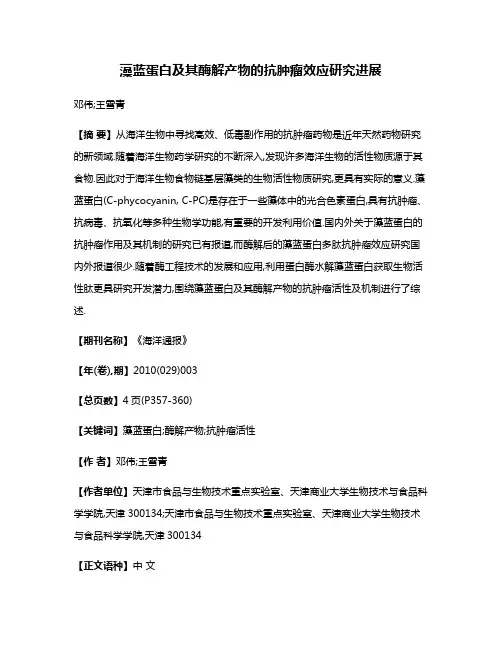
藻蓝蛋白及其酶解产物的抗肿瘤效应研究进展邓伟;王雪青【摘要】从海洋生物中寻找高效、低毒副作用的抗肿瘤药物是近年天然药物研究的新领域.随着海洋生物药学研究的不断深入,发现许多海洋生物的活性物质源于其食物.因此对于海洋生物食物链基层藻类的生物活性物质研究,更具有实际的意义.藻蓝蛋白(C-phycocyanin, C-PC)是存在于一些藻体中的光合色素蛋白,具有抗肿瘤、抗病毒、抗氧化等多种生物学功能,有重要的开发利用价值.国内外关于藻蓝蛋白的抗肿瘤作用及其机制的研究已有报道,而酶解后的藻蓝蛋白多肽抗肿瘤效应研究国内外报道很少.随着酶工程技术的发展和应用,利用蛋白酶水解藻蓝蛋白获取生物活性肽更具研究开发潜力,围绕藻蓝蛋白及其酶解产物的抗肿瘤活性及机制进行了综述.【期刊名称】《海洋通报》【年(卷),期】2010(029)003【总页数】4页(P357-360)【关键词】藻蓝蛋白;酶解产物;抗肿瘤活性【作者】邓伟;王雪青【作者单位】天津市食品与生物技术重点实验室、天津商业大学生物技术与食品科学学院,天津300134;天津市食品与生物技术重点实验室、天津商业大学生物技术与食品科学学院,天津300134【正文语种】中文【中图分类】R282.77;R151.2藻胆蛋白是大量出现于红藻 (Rhodophyta)、蓝绿藻 (Cyanophyta) 和隐藻(Cryptophyta) 中的捕光色素蛋白,主要包括藻红蛋白 (R-PE)、藻蓝蛋白(C-PC)和别藻蓝蛋白 (APC) 3种。
藻胆蛋白在藻类细胞中的主要功能是作为光合作用捕光色素系统,把捕获的光能高效地传递给叶绿素,从而使海藻的光合作用得以发生[1]。
藻蓝蛋白 (Phycocyanin) 是从螺旋藻中提取的藻胆蛋白的一种,其氨基酸组成合理,其中必需氨基酸占氨基酸总量的37.42%。
大量的临床研究结果表明[2-9],藻蓝蛋白具有抗肿瘤、抗辐射、抗疲劳、调节免疫力、清除自由基、促进细胞生长和保护神经等生理作用。
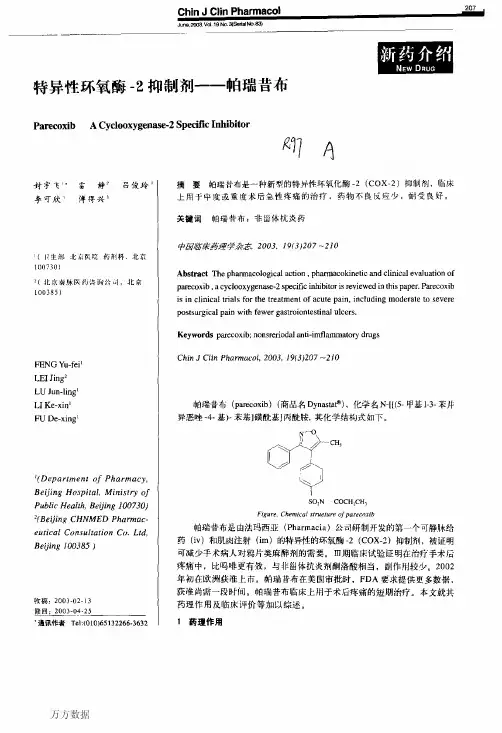
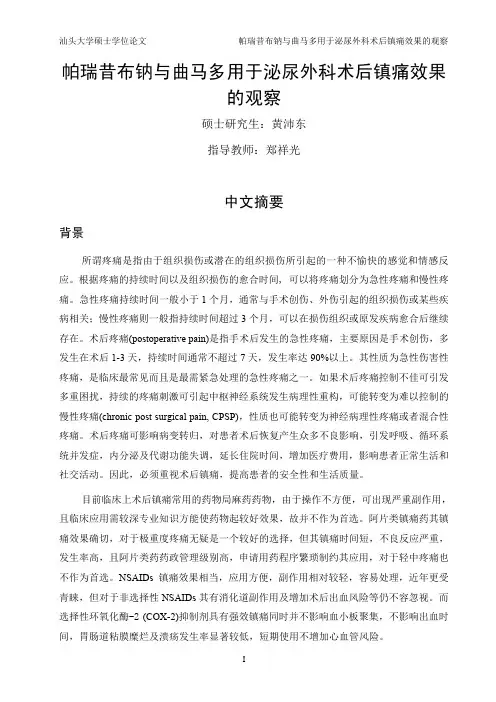
帕瑞昔布钠与曲马多用于泌尿外科术后镇痛效果的观察硕士研究生:黄沛东指导教师:郑祥光中文摘要背景所谓疼痛是指由于组织损伤或潜在的组织损伤所引起的一种不愉快的感觉和情感反应。
根据疼痛的持续时间以及组织损伤的愈合时间, 可以将疼痛划分为急性疼痛和慢性疼痛。
急性疼痛持续时间一般小于1个月,通常与手术创伤、外伤引起的组织损伤或某些疾病相关;慢性疼痛则一般指持续时间超过3个月,可以在损伤组织或原发疾病愈合后继续存在。
术后疼痛(postoperative pain)是指手术后发生的急性疼痛,主要原因是手术创伤,多发生在术后1-3天,持续时间通常不超过7天,发生率达90%以上。
其性质为急性伤害性疼痛,是临床最常见而且是最需紧急处理的急性疼痛之一。
如果术后疼痛控制不佳可引发多重困扰,持续的疼痛刺激可引起中枢神经系统发生病理性重构,可能转变为难以控制的慢性疼痛(chronic post surgical pain, CPSP),性质也可能转变为神经病理性疼痛或者混合性疼痛。
术后疼痛可影响病变转归,对患者术后恢复产生众多不良影响,引发呼吸、循环系统并发症,内分泌及代谢功能失调,延长住院时间,增加医疗费用,影响患者正常生活和社交活动。
因此,必须重视术后镇痛,提高患者的安全性和生活质量。
目前临床上术后镇痛常用的药物局麻药药物,由于操作不方便,可出现严重副作用,且临床应用需较深专业知识方能使药物起较好效果,故并不作为首选。
阿片类镇痛药其镇痛效果确切,对于极重度疼痛无疑是一个较好的选择,但其镇痛时间短,不良反应严重,发生率高,且阿片类药药政管理级别高,申请用药程序繁琐制约其应用,对于轻中疼痛也不作为首选。
NSAIDs镇痛效果相当,应用方便,副作用相对较轻,容易处理,近年更受青睐,但对于非选择性NSAIDs其有消化道副作用及增加术后出血风险等仍不容忽视。
而选择性环氧化酶-2 (COX-2)抑制剂具有强效镇痛同时并不影响血小板聚集,不影响出血时间,胃肠道粘膜糜烂及溃疡发生率显著较低,短期使用不增加心血管风险。
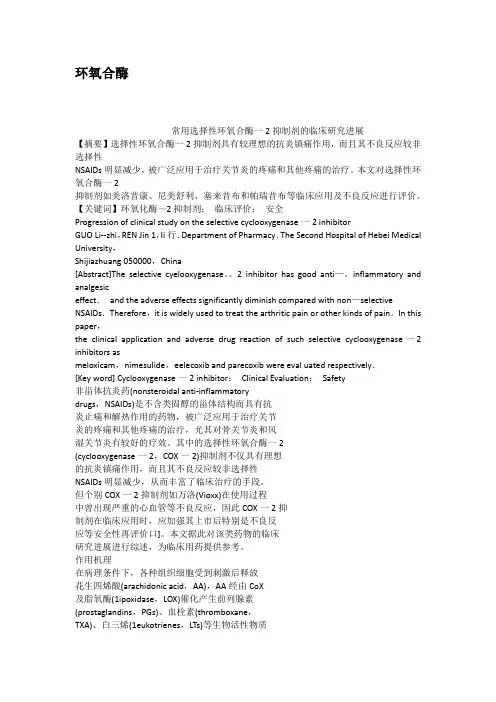
环氧合酶常用选择性环氧合酶一2抑制剂的临床研究进展【摘要】选择性环氧合酶一2抑制剂具有较理想的抗炎镇痛作用,而且其不良反应较非选择性NSAIDs明显减少,被广泛应用于治疗关节炎的疼痛和其他疼痛的治疗。
本文对选择性环氧合酶一2抑制剂如美洛昔康、尼美舒利、塞来昔布和帕瑞昔布等临床应用及不良反应进行评价。
【关键词】环氧化酶~2抑制剂;临床评价;安全Progression of clinical study on the selective cyclooxygenase一2 inhibitorGUO Li--zhi,REN Jin 1,li行.Department of Pharmacy.The Second Hospital of Hebei Medical University,Shijiazhuang 050000,China[Abstract]The selective cyelooxygenase。
2 inhibitor has good anti—。
inflammatory and analgesiceffect.and the adverse effects significantly diminish compared with non—selective NSAIDs.Therefore,it is widely used to treat the arthritic pain or other kinds of pain.In this paper,the clinical application and adverse drug reaction of such selective cyclooxygenase一2 inhibitors asmeloxicam,nimesulide,eelecoxib and parecoxib were eval uated respectively.[Key word] Cyclooxygenase一2 inhibitor;Clinical Evaluation;Safety非甾体抗炎药(nonsteroidal anti-inflammatorydrugs,NSAIDs)是不含类固醇的甾体结构而具有抗炎止痛和解热作用的药物,被广泛应用于治疗关节炎的疼痛和其他疼痛的治疗,尤其对骨关节炎和风湿关节炎有较好的疗效。
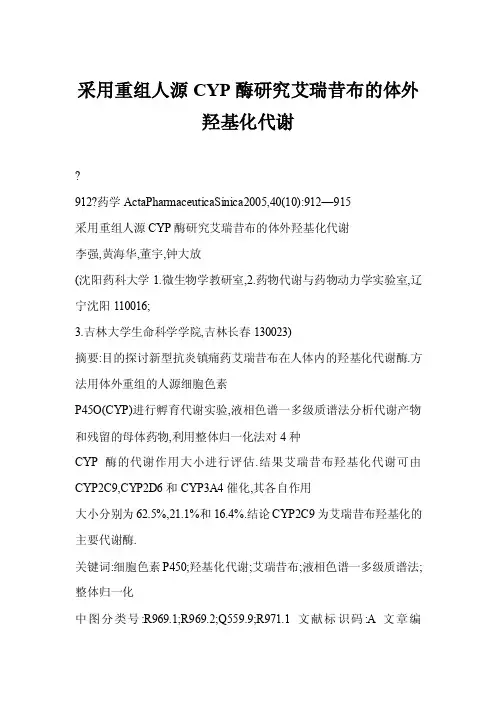
采用重组人源CYP酶研究艾瑞昔布的体外羟基化代谢912?药学ActaPharmaceuticaSinica2005,40(10):912—915采用重组人源CYP酶研究艾瑞昔布的体外羟基化代谢李强,黄海华,董宇,钟大放(沈阳药科大学1.微生物学教研室,2.药物代谢与药物动力学实验室,辽宁沈阳110016;3.吉林大学生命科学学院,吉林长春130023)摘要:目的探讨新型抗炎镇痛药艾瑞昔布在人体内的羟基化代谢酶.方法用体外重组的人源细胞色素P45O(CYP)进行孵育代谢实验,液相色谱一多级质谱法分析代谢产物和残留的母体药物,利用整体归一化法对4种CYP酶的代谢作用大小进行评估.结果艾瑞昔布羟基化代谢可由CYP2C9,CYP2D6和CYP3A4催化,其各自作用大小分别为62.5%,21.1%和16.4%.结论CYP2C9为艾瑞昔布羟基化的主要代谢酶.关键词:细胞色素P450;羟基化代谢;艾瑞昔布;液相色谱一多级质谱法;整体归一化中图分类号:R969.1;R969.2;Q559.9;R971.1文献标识码:A文章编号:0513—4870(2005)10—0912—04 Investigationonthehydroxylationmetabolismofimrecoxibinvitro byusingrecombinanthumanCYPsLIQiang,HUANGHai—hua,DONGY u,ZHONGDa—fang(J.DepartmentofPharmaceuticalMicrobiology,2 PharmaceuticalUniversity,Shenyang110016,China;3 LaboratoryofDrugMetabolismandPharmacokinetics,Shenyang CollegeofLifeScience,JilinUniversity,Changchun130023,China) Abstract:AimToidentifythedrug—metabolizingenzymesinvolvedinthehyd roxylationofthenew anti—inflammatoryandanodyneimrecoxib.MethotisImrecoxibwasincubat edwithheterologousexpressionhumancytochromeP450(rCYPs)invitro,andmetabolitesandrema inedparentdrugwere detectedwithliquidchromatography—multistagemassspectrometry.Thecon tributionof4CYPsinthe hydroxylationmetabolismofimrecoxibwasevaluatedbytotalnorlYlalizedrat e(TNR)method.ResultsImrecoxibiSmetabolizedbyCYP2C9,CYP2D6andCYP3A4,withtherateof6 2.5%.21.1%and16.4%.respectively.ConclusionCYP2C9iSthemajorenzymeinvolvedinimre coxibhydroxylationmetabolism.Keywords:cytochromeP450;hydroxylationmetabolism:imrecoxib;liquidch romatography—multistagemassspectrometry:totalnormalizedrate艾瑞昔布(imrecoxib,图1)为我国正在研制开发中的新药,环氧化酶一2(COX.2)特异性抑制剂,对因炎性介质引起的环氧化酶_2的生成有较强抑制作用,进而发挥止痛及抗炎作用¨.研究表明,该药在人体内绝大部分以代谢物形式消除,主要代谢途径是经肝脏代谢为4O/一羟基代谢产物M1,尿液中收稿日期:2004—11—18.基金项目:国家高技术研究发展{I-划(863计划)课题(2003AA2Z347C).通讯作者Tel:86—24—23843711—3795,Fax:86—24—23902539. E—mail:*****************几乎只能检测到进一步氧化的4O/一羧基代谢产物M2.》O/cHRImrecoxib:R=CH3;M1:R=CH2OH;M2:R=COOHFigure1Structuresofimrecoxibanditsmainmetabolites(M1andM2)强等:采用重组人源CYP酶研究艾瑞昔布的体外羟基化代谢’913?目前国外已经上市的同类药物有罗非昔布(rofecoxib),伐地昔布(valdecoxib)和依他昔布(etoricoxib)等,其结构有一定相似性,主要由CYP2C9及CYP3A4代谢口~.为探讨艾瑞昔布在人体内的主要代谢酶,本文利用重组人源CYP酶对该药进行体外代谢研究,通过液相色谱一多级质谱(LC—MS”)方法检测其代谢产物,利用整体归一化(totalnormalizedrate.TNR)法对参与代谢CYP亚型的作用进行评估,并对其主要代谢酶的动力学性质进行初步探讨.材料与方法药物代谢重组酶人源重组rCYP2C9,rI=YP2C19.rCYP2D6及rCYP3A4购自CHT公司(SaltLake,美国),于一86℃低温冰箱内保存.药品和试剂甲苯磺丁脲(tolbutamide)原料药,由广州温泉药厂提供;氢溴酸右美沙芬(dextromethorphan)原料药和5一美芬妥英(5一mephenytoin)原料药,均由沈阳药科大学药剂教研室提供;盐酸咪达唑仑(midazolam)注射剂,罗氏有限公司.艾瑞昔布原料药,纯度为99.6%;内标物BAP910原料药,纯度为99.5%,均由江苏恒瑞医药股份有限公司提供.其余重组酶孵育体系试剂为市售分析纯,用于LC.MS”分析的试剂为色谱纯.主要仪器设备美国Finnigan公司LCQ型液相色谱-质谱联用仪,配有电喷雾离子化源(ESI)离子阱质量分析器和日本ShimadzuLC—lOAD高效液相输液泵及Xcalibur1.1数据处理系统;一86oC低温冰箱(日本三洋).重组酶孵育体系重组酶孵育体系介质为磷酸盐缓冲液,浓度为100mmol?L’.,p H7.4,含有重组酶50nmol?L’.,因艾瑞昔布不溶于水,孵育时加入甲醇溶液,终浓度为5mol?L~,有机相为最终体系的0.1%(v/v),以加入1mmol?LNADPH起始反应,最终体积为200IxL.在37℃水浴中孵育,反应至一定时间以等体积的冰冷甲醇终止反应.每次孵育均为双样本.重组CYP酶活力检测rCYP2C9酶活力检测用CYP2C9探针药物甲苯磺丁脲为底物,底物浓度为100Ixmol?L~.其余条件同重组酶孵育体系,LC.MS”法以负离子方式检测产物4一羟基甲苯磺丁脲生成速率,作为rCYP2C9 酶活指标.rCYP2C19酶活力检测用CYP2C19探针药物5.美芬妥英为底物,底物浓度为100ixmol?L~,LC—MS”法以正离子方式检测4.羟基代谢物生成速率. rCYP2D6酶活力检测用CYP2D6探针药物右美沙芬为底物,底物浓度为5mo1.L~,Lc—MS”法以正离子方式检测产物0-去甲基代谢物生成速率. rCYP3A4酶活力检测用CYP3A4探针药物咪达唑仑为底物,底物浓度为5I.zmol?L~,LC—MS”法以正离子方式检测产物1.羟基咪达唑仑生成速率. 重组酶对艾瑞昔布代谢能力的测定艾瑞昔布在孵育体系中的终浓度为5Ixmol?L~,分别与rCYP2C9,rCYP2C19,rCYP2D6和rCYP3A4在37℃水浴中孵育,各种酶终浓度均为50nmol?L~,用LC.MS”法测定艾瑞昔布4.羟基代谢产物M1生成速率.LC—MS法检测M1质谱条件:电喷雾离子化源,正离子方式检测.离子源喷射电压:4.5kV;毛细管温度:200oC;毛细管电压:13V;鞘气流速:1.05L?min~;辅助气流速:0.15L?min~;用一级全扫描方式,二级全扫描方式和选择反应监测方式. 色谱条件:色谱柱为DiamonsilC柱(200mm×4.6mmID,5Ixm,北京迪马公司);流动相为甲醇-水-甲酸(75:25:0.1,v/v/v);柱温:室温;流速:0.5mL?rain’..酶动力学参数测定根据文献要求,对艾瑞昔布羟化反应的主要代谢酶(代谢程度超过20%) rCYP2C9及rCYP2D6进行酶动力学考察,艾瑞昔布在孵育体系中的终浓度范围为0.1—40Ixmol?L’.,测定M1的生成速率,计算K,’,一.确证酶浓度与速率成线性酶浓度范围为5~80nmol?L’.,艾瑞昔布浓度为5txmol?L’.进行体外孵育,验证酶浓度与反应速率是否成线性关系.结果1酶活力检测对4种rCYP酶进行的酶活力检测结果证实,研究所用的重组酶均具有较强酶活力(表1),满足本研究的要求.Table1Themonitoredactivitiesof4rCYPs rcYPPmesusereacti.n.9l4?药学ActaPharmaeeuticaSinica2005,40(1O):912—915 2主要代谢酶对艾瑞昔布代谢能力的测定艾瑞昔布代谢后形成羟化产物M1,检测结果见图2和图3./州¨.”D.O/C运气I嚣I暑搴【I150200250300350400n:Figure2FullscanMSspectraofm/z386(M1) 0123456789lOlll2t|millFigure3Chromatogramsofimrecoxib(A),M1(B) andBAP910(C,internalstandard,IS)byselected reactionmonitoring(SRM)scanmoderCYP2C9和rCYP2D6对艾瑞昔布羟基化代谢能力的测定见图4.艾瑞昔布被rCYP2C9代谢成羟化产物M1的速皇主0102O3O40506070率为0.585pmol?min~?(pmolrCYP)~,被rCYP2D6 代谢成M1的速率为1.894pmol?min~.(pmol rCYP)~.艾瑞昔布和rCYP3A4在相同条件下孵育,检测计算M1的形成速率为0.136pmol?min~. (pmolrCYP)(图略).艾瑞昔布和rCYP2C19在相同条件下孵育60min,没有检测到M1形成.3主要代谢酶动力学参数由于艾瑞昔布在孵育体系中的溶解上限为40 Ixmol?L~,无法通过继续增大其浓度来获得更多的数据.所测得的数据利用Eadie?Hofsteeplots法进行处理(表2).Table2EnzymekineticsparametersofrCYP2C9and rCYP2D64验证酶浓度与酶促反应速率呈线性对rCYP2C9,rCYP2D6和rCYP3A4进行的酶浓度. 反应速率线性考察,表明这3种酶在5~80nmol?L~, 酶浓度与反应速率呈线性关系,rCYP2C9酶浓度与反应速率见图5,rCYP2D6和rCYP3A4数据未列出.50g_”J;302o10》O0lO2O3O405O6O7080C/nmo1.I『1Figure5ReactionvelocitieslinearwithrCYP2C9concentrationt|mlnFigure4TimecourseofM1productionincubatedwithrCYP2C9andrCYP2D6, separately.A:Incubationat37oCwith50nmol?L~rCYP2C9and5Ixmol?L~imrecoxib:B:Incubationat37oCwith50nmol?L一rCYP2D6and5Ixmol?L一imrecoxib笛矗口虽盎矗Il矗_∞踟∞∞加O∞踟∞∞加O∞踟∞∞加O皇矗皇皇毒矗0薯O853O853O2llllOOO李强等:采用重组人源CYP酶研究艾瑞昔布的体外羟基化代谢5TNR法评估各rCYP酶作用大小在本文所采用的重组酶体系中,发现rCYP2C9,rCYP2D6和rCYP3A4可代谢艾瑞昔布,利用TNR法对其各自作用大小进行评估,结果见表3.Table3FormationofM1byrecombinantCYPproteinsIncubationat37qCwith50nmol?L~rCYPand5p,mol?L~imrecoxib:”MeanspecificcontentofCⅥinnativehuman livermicI_0s0mes-]TNR法为一种利用重组CYP酶评估各种CYP亚型对药物代谢程度大小的方法,其公式如下:%TNR=pmol/min/pmolrCYPnpmolmCYPn/mg×l00∑(?)…讨论药物消除主要以代谢物或以原形物形式排出体外,若主要以代谢物形式进行,则代谢情况会很大程度上影响药物的使用安全性及药理作用.药物代谢中,肝脏中的CYP450酶系对药物的氧化代谢占据主要位置.而某些CYP亚型(如CYP2D6,CYP2C19)在人群中呈多态分布,有显着的个体及种族差异,用药时应考虑到这些差异.采用个体化用药能更好地发挥药物的作用,减少不良反应.某些CYP酶(如CYP2C9)可被相应药物诱导或抑制,不恰当的联合给药将导致药物相互作用,引起药物药理活性和安全性的改变,例如当临床治疗中药物达稳态后联合使用CYP450诱导剂或抑制剂,则往往需要调整药物的剂量,以求获得最好的临床效果J.因此对药物的CYP代谢酶的确证对于预测药物之间的相互作用及个体化用药都十分重要. 进行药物代谢体外研究主要包括亚细胞水平和细胞水平,目前以亚细胞水平研究为主,通常利用肝微粒体进行,但人肝微粒体难以获得,且受捐献者生理或病理情况影响.近年来,随着基因工程重组人源CYP纯酶的商品化,利用重组CYP进行体外药物代谢研究已成为药物代谢研究的一个重要方面, 并逐渐发展成为一种常规方法.利用TNR法评估药物被CYP各亚型代谢程度,所得结果同抑制实验,相关性实验结果具有较好的一致性.但由于重组酶与真实的CYP存在一定差别,主要表现在蛋白环境,与NADPH-还原酶的比例不尽相同,其实验结果可能与人体生理真实情况有所差异,但仍不失为一种准确,快速确定药物CYP代谢亚型的方法.本文通过体外人源重组CYP酶法确定了艾瑞昔布羟基化代谢酶为CYP2C9,CYP2D6,CYP3A4.在本文实验条件下利用TNR法对其各自作用大小做出评估,由结果可以看出艾瑞昔布经过多种CYP 亚型代谢,并以CYP2C9为主.同时使用CYP2C9底物或可诱导或抑制CYP2C9的药物(如利福平或磺胺苯吡唑)时可能会对艾瑞昔布药效产生一定影响;艾瑞昔布在人体内代谢迅速,也可能是在肝中被多种CYP亚型广泛代谢及在肠道中被CYP3A4 代谢所致.References[1]BaiAP,GuoZR,HuWH,eta1.Design,synthesisand invitroevaluationofanewclassofnoveleyelooxygenase- 2inhibitors:3,4-diaryl-3一pyrrolin-2一ones[J].Chin ChemLett.2001,12(9):775—778.[2]SlaughterD,TakenagaN,LuP,eta1.Metabolismof rolecoxibvitrousinghumanliversubeellularfractions [J].DrugMetabD却OS,2003,31(11):1398—1408. [3]IbrahimA,KarimA,FeldmanJ.eta1.Theinflueneeof parecoxib,aparenteraleyelooxygenase-2specific inhibitor.onthepharmaeokinetiesandclinicaleffectsof midazolam[J].AnesthAnalg,2002,95(3):667—673.14lKassahunK.McIntoshIS.ShouM,eta1.Roleofhuman livercytochromeP4503Ainthemetabolismofetoricoxib,anovelcyclooxygenase-2selectiveinhibitor[J].Drug MetabDispos,2001,29(6):813—820.[5]RodriguesAD.IntegratedcytochromeP450reaction phenotyping.Attemptingtobridgethegapbetween cDNA.expressedcytochromesP450andnativehuman livermierosomeslJ1.BiochemPharmacol.1999,57(5):465—480.[6]TheFoodandDrugAdministration.Drugmetabolism/ druginteractionstudiesinthedrugdevelopmentprocess: studiesinvitro[S].1997.。
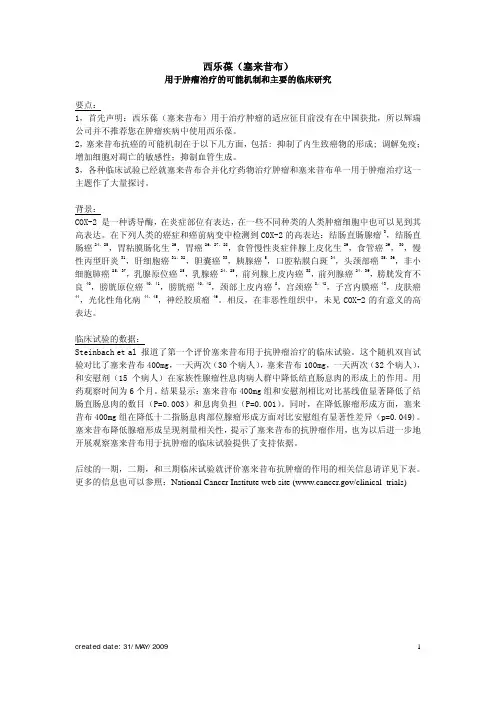
西乐葆(塞来昔布)用于肿瘤治疗的可能机制和主要的临床研究要点:1,首先声明:西乐葆(塞来昔布)用于治疗肿瘤的适应征目前没有在中国获批,所以辉瑞公司并不推荐您在肿瘤疾病中使用西乐葆。
2,塞来昔布抗癌的可能机制在于以下几方面,包括: 抑制了内生致癌物的形成; 调解免疫;增加细胞对凋亡的敏感性;抑制血管生成。
3,各种临床试验已经就塞来昔布合并化疗药物治疗肿瘤和塞来昔布单一用于肿瘤治疗这一主题作了大量探讨。
背景:COX-2 是一种诱导酶,在炎症部位有表达,在一些不同种类的人类肿瘤细胞中也可以见到其高表达。
在下列人类的癌症和癌前病变中检测到C0X-2的高表达:结肠直肠腺瘤3,结肠直肠癌24,25,胃粘膜肠化生26,胃癌26,27,28,食管慢性炎症伴腺上皮化生29,食管癌29,30,慢性丙型肝炎31,肝细胞癌31,32,胆囊癌33,胰腺癌5,口腔粘膜白斑34,头颈部癌35,36,非小细胞肺癌25,37,乳腺原位癌25,乳腺癌24,25,前列腺上皮内癌38,前列腺癌24,39,膀胱发育不良40,膀胱原位癌40,41,膀胱癌40,42,颈部上皮内癌8,宫颈癌8,42,子宫内膜癌43,皮肤癌44,光化性角化病44,45,神经胶质瘤46。
相反,在非恶性组织中,未见COX-2的有意义的高表达。
临床试验的数据:Steinbach et al 报道了第一个评价塞来昔布用于抗肿瘤治疗的临床试验。
这个随机双盲试验对比了塞来昔布400mg,一天两次(30个病人),塞来昔布100mg,一天两次(32个病人),和安慰剂(15个病人)在家族性腺瘤性息肉病人群中降低结直肠息肉的形成上的作用。
用药观察时间为6个月。
结果显示:塞来昔布400mg组和安慰剂相比对比基线值显著降低了结肠直肠息肉的数目(P=0.003)和息肉负担(P=0.001)。
同时,在降低腺瘤形成方面,塞来昔布400mg组在降低十二指肠息肉部位腺瘤形成方面对比安慰组有显著性差异(p=0.049)。
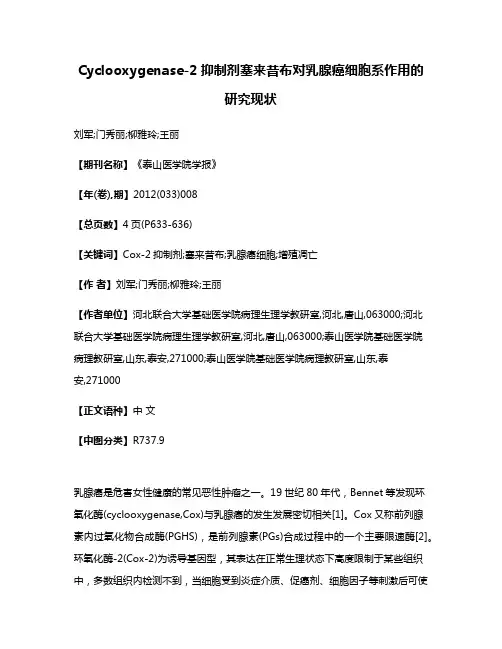
Cyclooxygenase-2抑制剂塞来昔布对乳腺癌细胞系作用的研究现状刘军;门秀丽;柳雅玲;王丽【期刊名称】《泰山医学院学报》【年(卷),期】2012(033)008【总页数】4页(P633-636)【关键词】Cox-2抑制剂;塞来昔布;乳腺癌细胞;增殖凋亡【作者】刘军;门秀丽;柳雅玲;王丽【作者单位】河北联合大学基础医学院病理生理学教研室,河北,唐山,063000;河北联合大学基础医学院病理生理学教研室,河北,唐山,063000;泰山医学院基础医学院病理教研室,山东,泰安,271000;泰山医学院基础医学院病理教研室,山东,泰安,271000【正文语种】中文【中图分类】R737.9乳腺癌是危害女性健康的常见恶性肿瘤之一。
19世纪80年代,Bennet等发现环氧化酶(cyclooxygenase,Cox)与乳腺癌的发生发展密切相关[1]。
Cox又称前列腺素内过氧化物合成酶(PGHS),是前列腺素(PGs)合成过程中的一个主要限速酶[2]。
环氧化酶-2(Cox-2)为诱导基因型,其表达在正常生理状态下高度限制于某些组织中,多数组织内检测不到,当细胞受到炎症介质、促癌剂、细胞因子等刺激后可使Cox-2诱导性表达[3]。
Cox-2及其催化产物PGs不仅广泛参与机体炎症等多种过程,而且可通过多种致病机制参与许多实体瘤的发生、发展过程。
Cox-2抑制剂在乳腺癌中的应用也受到广泛关注[4]。
作为环氧化酶-2抑制剂之一的塞来昔布,能抑制细胞增生,调节细胞周期,并且促进细胞凋亡。
它的作用一直在许多乳腺癌临床预实验中被研究[5]。
1 Cox-2抑制剂塞来昔布塞来昔布(商品名为西乐葆,celecoxib)作为一种新型NASIDs(非甾体抗炎药),是一种高选择Cox-2抑制剂,其靶向性强,副作用小。
它可以选择性阻断Cox-2,而不阻断Cox-1,从而减少传统非甾体类抗炎药如阿司匹林、吲哚美辛等对消化道黏膜的损伤[6]。
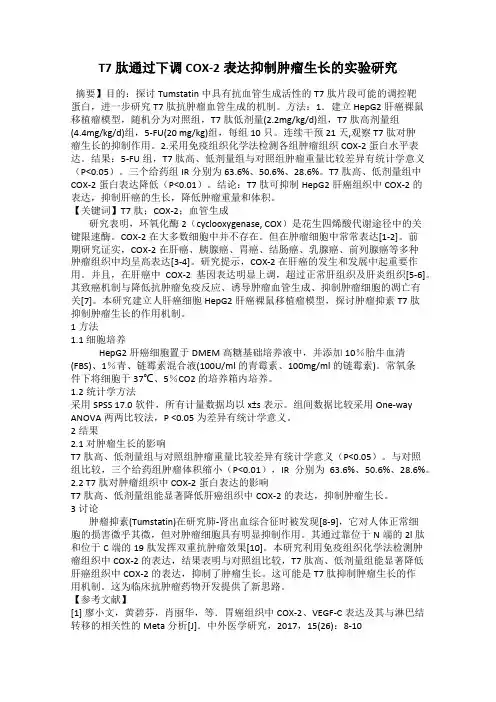
T7肽通过下调COX-2表达抑制肿瘤生长的实验研究摘要】目的:探讨Tumstatin中具有抗血管生成活性的T7肽片段可能的调控靶蛋白,进一步研究T7肽抗肿瘤血管生成的机制。
方法:1.建立HepG2肝癌裸鼠移植瘤模型,随机分为对照组,T7肽低剂量(2.2mg/kg/d)组,T7肽高剂量组(4.4mg/kg/d)组,5-FU(20 mg/kg)组,每组10只。
连续干预21天,观察T7肽对肿瘤生长的抑制作用。
2.采用免疫组织化学法检测各组肿瘤组织COX-2蛋白水平表达。
结果:5-FU组,T7肽高、低剂量组与对照组肿瘤重量比较差异有统计学意义(P<0.05)。
三个给药组IR分别为63.6%、50.6%、28.6%。
T7肽高、低剂量组中COX-2蛋白表达降低(P<0.01)。
结论:T7肽可抑制HepG2肝癌组织中COX-2的表达,抑制肝癌的生长,降低肿瘤重量和体积。
【关键词】T7肽;COX-2;血管生成研究表明,环氧化酶2(cyclooxygenase, COX)是花生四烯酸代谢途径中的关键限速酶。
COX-2在大多数细胞中并不存在。
但在肿瘤细胞中常常表达[1-2]。
前期研究证实,COX-2在肝癌、胰腺癌、胃癌、结肠癌、乳腺癌、前列腺癌等多种肿瘤组织中均呈高表达[3-4]。
研究提示,COX-2在肝癌的发生和发展中起重要作用。
并且,在肝癌中COX-2基因表达明显上调,超过正常肝组织及肝炎组织[5-6]。
其致癌机制与降低抗肿瘤免疫反应、诱导肿瘤血管生成、抑制肿瘤细胞的凋亡有关[7]。
本研究建立人肝癌细胞HepG2肝癌裸鼠移植瘤模型,探讨肿瘤抑素T7肽抑制肿瘤生长的作用机制。
1方法1.1细胞培养HepG2肝癌细胞置于DMEM高糖基础培养液中,并添加10%胎牛血清(FBS)、1%青、链霉素混合液(100U/ml的青霉素、100mg/ml的链霉素)。
常氧条件下将细胞于37℃、5%CO2的培养箱内培养。
1.2统计学方法采用SPSS 17.0软件,所有计量数据均以x±s表示。
COX-2在胆管癌中的表达及其选择性抑制剂对胆管癌细胞生长的影响杨博;马亦龙【摘要】目的:评估环氧合酶-2(COX-2)抑制剂塞来昔布对胆管癌细胞株QBC939生长和凋亡的影响。
方法通过western blot实验检测COX-2蛋白在胆管癌标本、胆管癌细胞株QBC939和肝内胆管上皮细胞HIBEpiC中的表达水平;通过WST-1实验检测塞来昔布对QBC939细胞生长的影响;通过裸鼠荷瘤模型评估塞来昔布在体内对QBC939细胞生长的影响;通过凋亡实验检测塞来昔布对QBC939细胞凋亡的影响。
结果 COX-2蛋白在胆管癌组织中表达水平显著高于癌旁组织,在QBC939细胞中的表达水平显著高于HIBEpiC细胞;塞来昔布在体内和体外均可显著抑制QBC939细胞的生长;塞来昔布可诱导QBC939细胞发生凋亡。
结论 COX-2抑制剂塞来昔布对胆管癌细胞的生长有显著抑制作用,该作用可能与其诱导细胞凋亡有关。
%Objective To evaluate the effects of Celecoxib,a selective cyclooxygenase-2 inhibitor,on the proliferation and apoptosis of QBC939 cells. Methods The expression of COX-2 in the tissue samples,QBC939 cells and HIBEpiC cells was examined using western blot assay. The in vitro inhibitory effects of Celecoxib on the proliferation of QBC939 cells were tested using WST-1 assay. The in vivo inhibitory effects of Celecoxib on the proliferation of QBC939 cells were evaluated on animal xenograft tumor models. In addition,the effects of Celecoxib on apoptosis of QBC939 cells were evaluated using Annexin V-FITC assay. Results The level of COX-2 expression in cholangiocarcinoma tissues was significantly higher than that in normal tissues and its expression in QBC939 cells wasalso significantly higher than that in HIBEpiC cells. Celecoxib significantly inhibited the proliferation of QBC939 cells in vitro and in vivo. In addition,Celecoxib induced apoptosis of QBC939 cells significantly. Conclusion Celecoxib can induce significant apoptosis on QBC939 cells which may lead to growth inhibition of QBC939 cells in vitro and in vivo.【期刊名称】《浙江临床医学》【年(卷),期】2015(000)003【总页数】3页(P384-385,386)【关键词】胆管癌;环氧合酶-2抑制剂;凋亡【作者】杨博;马亦龙【作者单位】530021 广西医科大学附属肿瘤医院介入治疗科;530021 广西医科大学附属肿瘤医院介入治疗科【正文语种】中文目前胆管癌缺乏标准规范的化疗方案,众多基础实验和临床试验均证明常规化疗方案对胆管癌的疗效并不显著[1]。
塞来昔布诱导人椎间盘细胞表达神经生长因子陈小明;周润梅;欧斌;曹奇【摘要】目的研究环氧化酶2抑制剂塞来昔布以及前列腺素E2(PGE2)对神经生长因子(NGF)表达的影响.方法分离培养人椎间盘(IVD)细胞,用不同浓度的塞来昔布预处理30 min后,加入10 ng/mL IL-1β作用6h.RT-PCR和ELISA分别检测NGF mRNA和蛋白的表达,ELISA检测PGE2的分泌.同时加入外源性PGE2以及其受体(EPs1 ~4)激动剂,观察其对NGF产生的影响.结果 IL-1β作用3h即可以一定的时间依赖性诱导IVD细胞表达NGFmRNA.塞来昔布处理后能使NGF mRNA水平进一步增加1.8倍.IL-1β处理后,PGE2含量达(5.46±0.64) ng/mL.10 mmol/L塞来昔布能将其降低至(1.07±0.04)ng/mL(P <0.05).IVD细胞经100 μmol/L PGE2处理后,IL-1β诱导的NGF降低了59% (P <0.05).此外,采用EP2和EP4受体激动剂处理IVD细胞后,也得到了类似的结果,而EP1和EP3激动剂处理对NGF产生无明显影响.结论塞来昔布能促进IVD细胞表达NGF,其机制可能与抑制PGE2的分泌有关.【期刊名称】《基础医学与临床》【年(卷),期】2014(034)007【总页数】5页(P945-949)【关键词】神经生长因子;椎间盘细胞;前列腺素E2;塞来昔布【作者】陈小明;周润梅;欧斌;曹奇【作者单位】南华大学附属第二医院脊柱外科,湖南衡阳421001;南华大学药学与生命科学学院药物药理研究所,湖南衡阳421001;南华大学附属第二医院脊柱外科,湖南衡阳421001;南华大学附属第二医院脊柱外科,湖南衡阳421001【正文语种】中文【中图分类】R684.3腰痛是脊柱外科最常见的疾病,是导致患者丧失劳动力以及致残的重要因素。
本病在全世界范围内呈上升趋势,虽然人椎间盘(intervertebral disc,IVD)退行性变性是导致腰痛的主要原因,但其发病机制仍不清楚[1]。
矿产资源开发利用方案编写内容要求及审查大纲
矿产资源开发利用方案编写内容要求及《矿产资源开发利用方案》审查大纲一、概述
㈠矿区位置、隶属关系和企业性质。
如为改扩建矿山, 应说明矿山现状、
特点及存在的主要问题。
㈡编制依据
(1简述项目前期工作进展情况及与有关方面对项目的意向性协议情况。
(2 列出开发利用方案编制所依据的主要基础性资料的名称。
如经储量管理部门认定的矿区地质勘探报告、选矿试验报告、加工利用试验报告、工程地质初评资料、矿区水文资料和供水资料等。
对改、扩建矿山应有生产实际资料, 如矿山总平面现状图、矿床开拓系统图、采场现状图和主要采选设备清单等。
二、矿产品需求现状和预测
㈠该矿产在国内需求情况和市场供应情况
1、矿产品现状及加工利用趋向。
2、国内近、远期的需求量及主要销向预测。
㈡产品价格分析
1、国内矿产品价格现状。
2、矿产品价格稳定性及变化趋势。
三、矿产资源概况
㈠矿区总体概况
1、矿区总体规划情况。
2、矿区矿产资源概况。
3、该设计与矿区总体开发的关系。
㈡该设计项目的资源概况
1、矿床地质及构造特征。
2、矿床开采技术条件及水文地质条件。
矿产资源开发利用方案编写内容要求及审查大纲
矿产资源开发利用方案编写内容要求及《矿产资源开发利用方案》审查大纲一、概述
㈠矿区位置、隶属关系和企业性质。
如为改扩建矿山, 应说明矿山现状、
特点及存在的主要问题。
㈡编制依据
(1简述项目前期工作进展情况及与有关方面对项目的意向性协议情况。
(2 列出开发利用方案编制所依据的主要基础性资料的名称。
如经储量管理部门认定的矿区地质勘探报告、选矿试验报告、加工利用试验报告、工程地质初评资料、矿区水文资料和供水资料等。
对改、扩建矿山应有生产实际资料, 如矿山总平面现状图、矿床开拓系统图、采场现状图和主要采选设备清单等。
二、矿产品需求现状和预测
㈠该矿产在国内需求情况和市场供应情况
1、矿产品现状及加工利用趋向。
2、国内近、远期的需求量及主要销向预测。
㈡产品价格分析
1、国内矿产品价格现状。
2、矿产品价格稳定性及变化趋势。
三、矿产资源概况
㈠矿区总体概况
1、矿区总体规划情况。
2、矿区矿产资源概况。
3、该设计与矿区总体开发的关系。
㈡该设计项目的资源概况
1、矿床地质及构造特征。
2、矿床开采技术条件及水文地质条件。
矿产资源开发利用方案编写内容要求及审查大纲
矿产资源开发利用方案编写内容要求及《矿产资源开发利用方案》审查大纲一、概述
㈠矿区位置、隶属关系和企业性质。
如为改扩建矿山, 应说明矿山现状、
特点及存在的主要问题。
㈡编制依据
(1简述项目前期工作进展情况及与有关方面对项目的意向性协议情况。
(2 列出开发利用方案编制所依据的主要基础性资料的名称。
如经储量管理部门认定的矿区地质勘探报告、选矿试验报告、加工利用试验报告、工程地质初评资料、矿区水文资料和供水资料等。
对改、扩建矿山应有生产实际资料, 如矿山总平面现状图、矿床开拓系统图、采场现状图和主要采选设备清单等。
二、矿产品需求现状和预测
㈠该矿产在国内需求情况和市场供应情况
1、矿产品现状及加工利用趋向。
2、国内近、远期的需求量及主要销向预测。
㈡产品价格分析
1、国内矿产品价格现状。
2、矿产品价格稳定性及变化趋势。
三、矿产资源概况
㈠矿区总体概况
1、矿区总体规划情况。
2、矿区矿产资源概况。
3、该设计与矿区总体开发的关系。
㈡该设计项目的资源概况
1、矿床地质及构造特征。
2、矿床开采技术条件及水文地质条件。